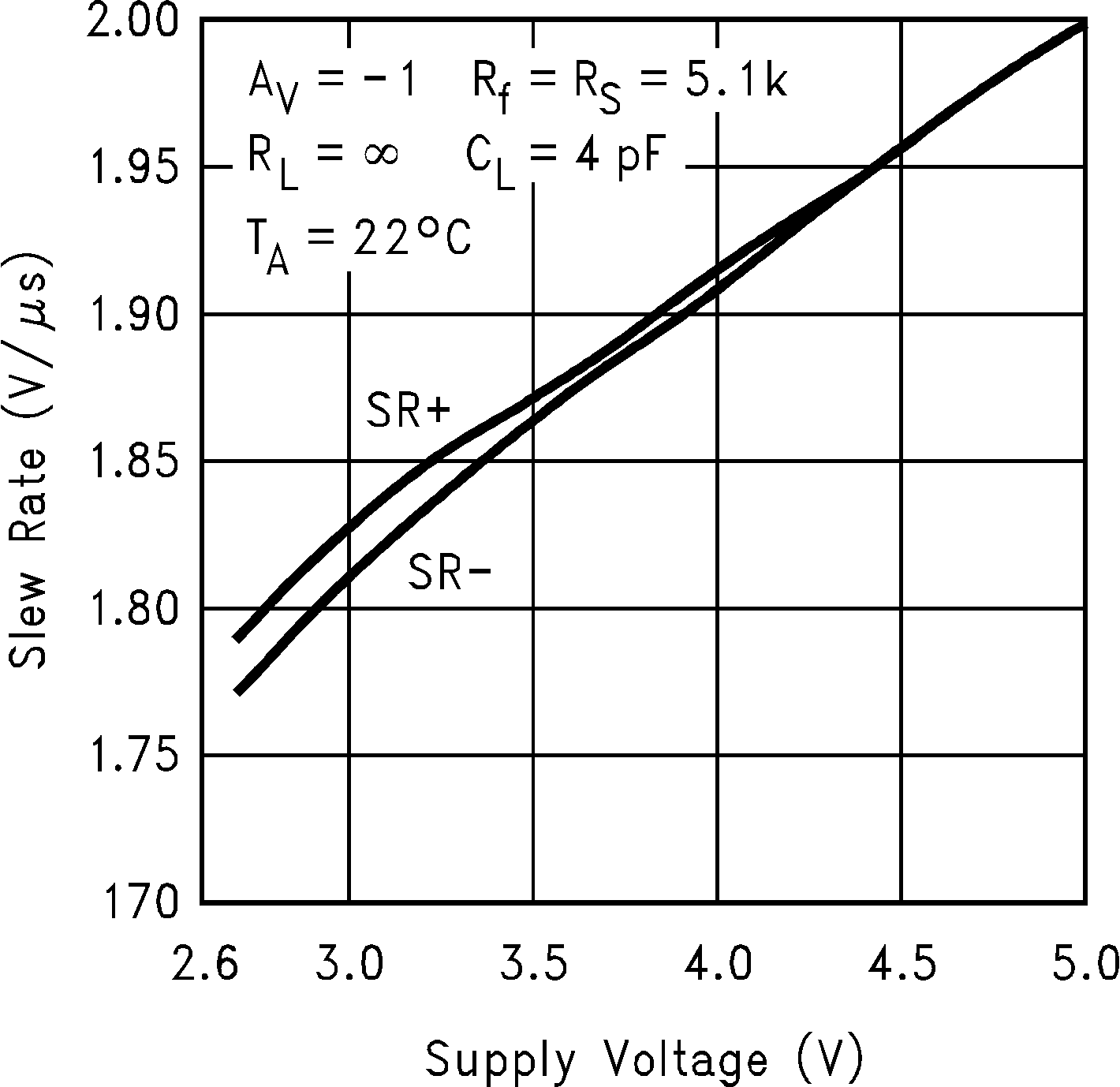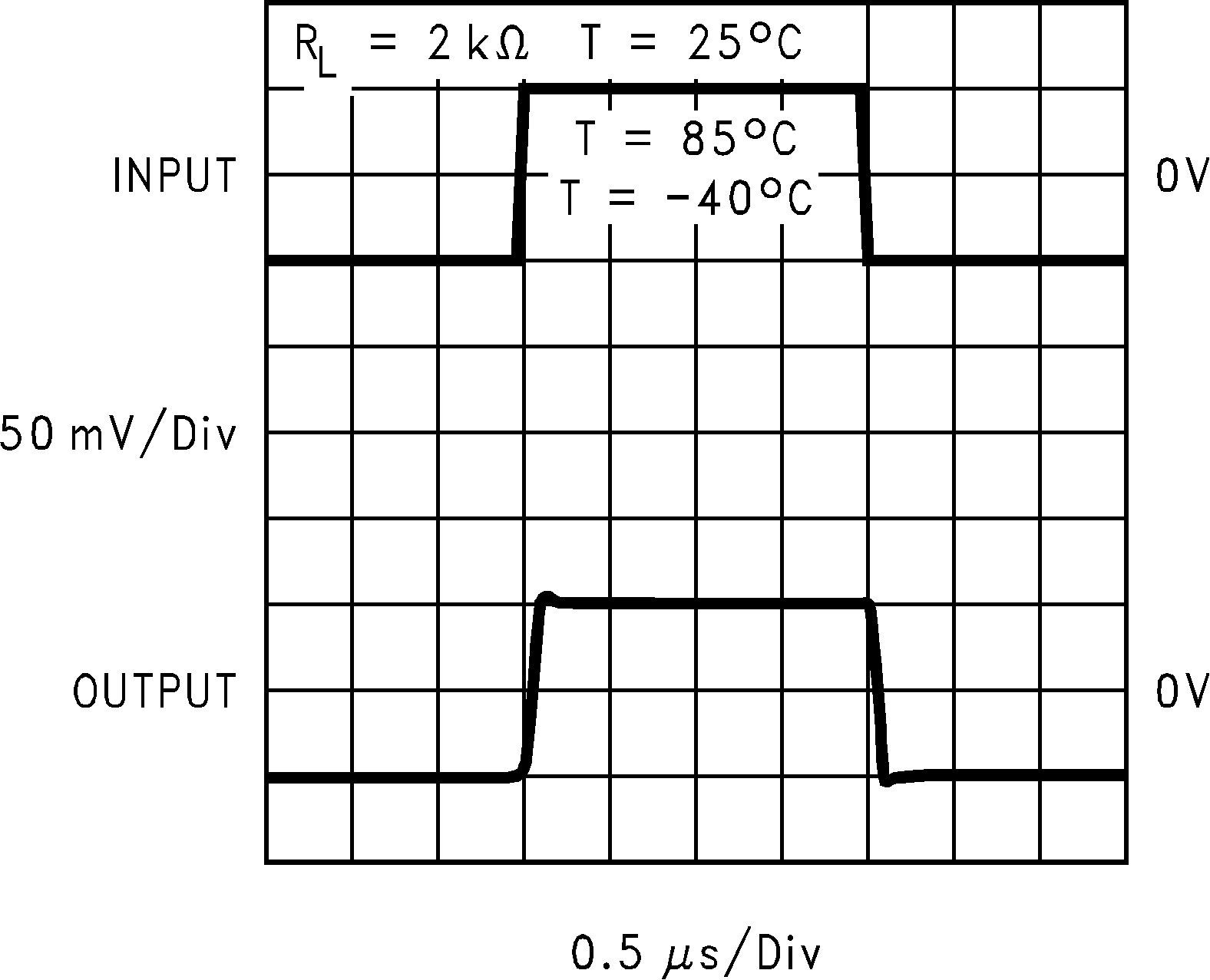SNOS032I August 1999 – June 2016 LMV821-N , LMV822-N , LMV822-N-Q1 , LMV824-N , LMV824-N-Q1
PRODUCTION DATA.
- 1 Features
- 2 Applications
- 3 Description
- 4 Revision History
- 5 Pin Configuration and Functions
-
6 Specifications
- 6.1 Absolute Maximum Ratings
- 6.2 ESD Ratings
- 6.3 Recommended Operating Conditions
- 6.4 Thermal Information, 5 Pins
- 6.5 Thermal Information, 8 Pins
- 6.6 Thermal Information, 14 Pins
- 6.7 DC Electrical Characteristics 2.7V
- 6.8 DC Electrical Characteristics 2.5V
- 6.9 AC Electrical Characteristics 2.7V
- 6.10 DC Electrical Characteristics 5V
- 6.11 AC Electrical Characteristics 5V
- 6.12 Typical Characteristics
- 7 Detailed Description
- 8 Application and Implementation
- 9 Power Supply Recommendations
- 10Layout
- 11Device and Documentation Support
- 12Mechanical, Packaging, and Orderable Information
Package Options
Mechanical Data (Package|Pins)
- DGK|8
Thermal pad, mechanical data (Package|Pins)
- DGK|8
Orderable Information
6 Specifications
6.1 Absolute Maximum Ratings(1)(2)
| MIN | MAX | UNIT | |
|---|---|---|---|
| Differential Input Voltage | V– | V+ | V |
| Supply Voltage (V+– V −) | –0.3 | 5.5 | V |
| Output Short Circuit to V+(3) | See (3) | ||
| Output Short Circuit to V−(3) | See (3) | ||
| Soldering Information | |||
| Infrared or Convection (20 sec) | 235 | °C | |
| Junction Temperature(1) | 150 | °C | |
| Storage Temperature Tstg | –65 | 150 | °C |
(1) Absolute Maximum Ratings indicate limits beyond which damage to the device may occur. Operating Ratings indicate conditions for which the device is intended to be functional, but specific performance is not ensured. For ensured specifications and the test conditions, see the Electrical Characteristics.
(2) If Military/Aerospace specified devices are required, please contact the TI Sales Office/Distributors for availability and specifications.
(3) Applies to both single-supply and split-supply operation. Continuous short circuit operation at elevated ambient temperature can result in exceeding the maximum allowed junction temperature of 150°C. Output currents in excess of 45 mA over long term may adversely affect reliability.
6.2 ESD Ratings
| VALUE | UNIT | |||
|---|---|---|---|---|
| V(ESD) | Electrostatic discharge | Human body model (HBM), per ANSI/ESDA/JEDEC JS-001, all pins(1) (2)(3) | ±2000 | V |
| Human body model (HBM), per ANSI/ESDA/JEDEC JS-001, all pins (1) LMV821 | ±1500 | |||
| Machine Model (MM) (4) | ±200 | |||
(1) Level listed above is the passing level per ANSI, ESDA, and JEDEC JS-001. JEDEC document JEP155 states that 500-V HBM allows safe manufacturing with a standard ESD control process.
(2) Human body model, 1.5 kΩ in series wth 100 pF.
(3) AEC Q100-002 indicates HBM stressing is done in accordance with the ANSI/ESDA/JEDEC JS-001 specification for Q grade devices.
(4) Machine model, 200Ω in series with 100 pF.
6.3 Recommended Operating Conditions
| MIN | NOM | MAX | UNIT | ||
|---|---|---|---|---|---|
| Supply Voltage | 2.5 | 5.5 | V | ||
| Temperature Range | LMV821, LMV822, LMV824 | –40 | 85 | °C | |
| LMV822-Q1, LMV824I and LMV824-Q1 | –40 | 125 | |||
6.4 Thermal Information, 5 Pins(1)
| THERMAL METRIC(1) | DCK SC70-5 PACKAGE |
DBV SOT23-5 PACKAGE |
UNIT | |
|---|---|---|---|---|
| 5 PIN | 5 PIN | |||
| RθJA | Junction-to-ambient thermal resistance | 263.4 | 217.8 | °C/W |
| RθJC(top) | Junction-to-case (top) thermal resistance | 102.8 | 142.4 | °C/W |
| RθJB | Junction-to-board thermal resistance | 50.9 | 49.4 | °C/W |
| ψJT | Junction-to-top characterization parameter | 3.7 | 29.1 | °C/W |
| ψJB | Junction-to-board characterization parameter | 50.2 | 48.5 | °C/W |
| RθJC(bot) | Junction-to-case (bottom) thermal resistance | N/A | N/A | °C/W |
6.5 Thermal Information, 8 Pins(1)
| THERMAL METRIC(1) | D SOIC PACKAGE |
DGK VSSOP PACKAGE |
UNIT | |
|---|---|---|---|---|
| 8 PIN | 8 PIN | |||
| RθJA | Junction-to-ambient thermal resistance | 132.6 | 193.9 | °C/W |
| RθJC(top) | Junction-to-case (top) thermal resistance | 76.9 | 84.4 | °C/W |
| RθJB | Junction-to-board thermal resistance | 73.2 | 114.5 | °C/W |
| ψJT | Junction-to-top characterization parameter | 25.0 | 21.6 | °C/W |
| ψJB | Junction-to-board characterization parameter | 72.6 | 113.0 | °C/W |
| RθJC(bot) | Junction-to-case (bottom) thermal resistance | N/A | N/A | °C/W |
6.6 Thermal Information, 14 Pins(1)
| THERMAL METRIC(1) | D SOIC PACKAGE |
PW TSSOP PACKAGE |
DGV TVSOP PACKAGE |
UNIT | |
|---|---|---|---|---|---|
| 14 PIN | 14 PIN | 14 PIN | |||
| RθJA | Junction-to-ambient thermal resistance | 109.7 | 135.6 | 148.2 | °C/W |
| RθJC(top) | Junction-to-case (top) thermal resistance | 65.9 | 63.8 | 67.3 | °C/W |
| RθJB | Junction-to-board thermal resistance | 64.1 | 77.4 | 77.5 | °C/W |
| ψJT | Junction-to-top characterization parameter | 24.5 | 13.0 | 12.9 | °C/W |
| ψJB | Junction-to-board characterization parameter | 63.9 | 76.8 | 76.9 | °C/W |
| RθJC(bot) | Junction-to-case (bottom) thermal resistance | N/A | N/A | N/A | °C/W |
(1) For more information about traditional and new thermal metrics, see the Semiconductor and IC Package Thermal Metrics application report.
6.7 DC Electrical Characteristics 2.7V
Unless otherwise specified, all limits ensured for TJ = 25°C. V+ = 2.7V, V − = 0V, VCM = 1.0V, VO = 1.35V and RL > 1 MΩ. Temperature extremes are −40°C ≤ TJ ≤ 85°C for LMV821/822/824, and −40°C ≤ TJ ≤ 125°C for LMV822-Q1/LMV824-Q1/LMV824I.| PARAMETER | TEST CONDITIONS | MIN (3) | TYP (2) | MAX (3) | UNIT | |
|---|---|---|---|---|---|---|
| VOS | Input Offset Voltage | LMV821/822/822-Q1/824 | 1 | 3.5 | mV | |
| LMV821/822/822-Q1/824, Over Temperature | 4 | |||||
| LMV824-Q1/LMV824I | 1 | |||||
| LMV824-Q1/LMV824I, Over Tempeature | 5.5 | |||||
| TCVOS | Input Offset Voltage Average Drift | 1 | μV/°C | |||
| IB | Input Bias Current | 30 | 90 | nA | ||
| Over Temperature | 140 | |||||
| IOS | Input Offset Current | 0.5 | 30 | nA | ||
| Over Temperature | 50 | |||||
| CMRR | Common Mode Rejection Ratio | 0V ≤ VCM ≤ 1.7V | 70 | 85 | dB | |
| 0V ≤ VCM ≤ 1.7V, Over Temperature | 68 | |||||
| +PSRR | Positive Power Supply Rejection Ratio | 1.7V ≤ V+ ≤ 4V, V- = 1V, VO = 0V, VCM = 0V LMV821/822/824/824-Q1/LMV824I |
75 | 85 | dB | |
| 1.7V ≤ V+ ≤ 4V, V- = 1V, VO = 0V, VCM = 0V LMV821/822/824/824-Q1/LMV824I, Over Temperature |
70 | |||||
| LMV822-Q1 | 75 | 85 | ||||
| −PSRR | Negative Power Supply Rejection Ratio | -1.0V ≤ V- ≤ -3.3V, V+ = 1.7V, VO = 0V, VCM = 0V LMV821/822/824/824-Q1/LMV824I |
73 | 85 | dB | |
| -1.0V ≤ V- ≤ -3.3V, V+ = 1.7V, VO = 0V, VCM = 0V LMV821/822/824/824-Q1/LMV824I, Over Temperature |
70 | |||||
| LMV822-Q1 | 73 | 85 | ||||
| VCM | Input Common-Mode Voltage Range | For CMRR ≥ 50dB | –0.3 | –0.2 | V | |
| 1.9 | 2.0 | |||||
| AV | Large Signal Voltage Gain | Sourcing, RL = 600Ω to 1.35V, VO = 1.35V to 2.2V; LMV821/822/824 |
90 | 100 | dB | |
| Sourcing, RL = 600Ω to 1.35V, VO = 1.35V to 2.2V; LMV821/822/824, Over Temperature |
85 | |||||
| LMV822-Q1/LMV824-Q1/LMV824I | 90 | 100 | ||||
| Sinking, RL = 600Ω to 1.35V, VO = 1.35V to 0.5V LMV821/822/824 |
85 | 90 | dB | |||
| Sinking, RL = 600Ω to 1.35V, VO = 1.35V to 0.5V LMV821/822/824, Over Temperature |
80 | |||||
| LMV824I | 85 | 90 | ||||
| LMV824I, Over Temperature | 78 | |||||
| LMV822-Q1/LMV824-Q1 | 85 | 90 | ||||
| Sourcing, RL =2kΩ to 1.35V, VO = 1.35V to 2.2V; LMV821/822/824 |
95 | 100 | dB | |||
| Sourcing, RL =2kΩ to 1.35V, VO = 1.35V to 2.2V; LMV821/822/824, Over Temperature |
90 | |||||
| LMV822-Q1/LMV824-Q1/LMV824I | 95 | 100 | ||||
| Sinking, RL = 2kΩ to 1.35V, VO = 1.35V to 0.5V LMV821/822/824 |
90 | 95 | dB | |||
| Sinking, RL = 2kΩ to 1.35V, VO = 1.35V to 0.5V LMV821/822/824, Over Temperature |
85 | |||||
| LMV822-Q1/LMV824-Q1/LMV824I | 90 | 95 | ||||
| V O | Output Swing | V+ = 2.7V, RL= 600Ω to 1.35V | 2.50 | 2.58 | V | |
| 0.13 | 0.20 | |||||
| V+ = 2.7V, RL= 600Ω to 1.35V, Over Temp | 2.40 | 0.30 | ||||
| V+ = 2.7V, RL= 2kΩ to 1.35V | 2.60 | 2.66 | V | |||
| 0.08 | 0.120 | |||||
| V+ = 2.7V, RL= 2kΩ to 1.35V, Over Temp | 2.50 | 0.200 | ||||
| IO | Output Current | Sourcing, VO = 0V | 12 | 16 | mA | |
| Sinking, VO = 2.7V | 12 | 26 | ||||
| IS | Supply Current | LMV821 (Single) | 0.22 | 0.3 | mA | |
| LMV821, Over Temperature | 0.5 | |||||
| LMV822 (Dual) | 0.45 | 0.6 | mA | |||
| LMV822, Over Temperature | 0.8 | |||||
| LMV824 (Quad) | 0.72 | 1.0 | mA | |||
| LMV824, Over Temperature | 1.2 |
6.8 DC Electrical Characteristics 2.5V
Unless otherwise specified, all limits ensured for TJ = 25°C. V+ = 2.5V, V − = 0V, VCM = 1.0V, VO = 1.25V and RL > 1 MΩ. Temperature extremes are −40°C ≤ TJ ≤ 85°C for LMV821/822/824, and −40°C ≤ TJ ≤ 125°C for LMV822-Q1/LMV824-Q1/LMV824I.| PARAMETER | CONDITION | MIN (3) | TYP (2) | MAX (3) | UNIT | |
|---|---|---|---|---|---|---|
| VOS | Input Offset Voltage | LMV821/822/822-Q1/824 | 1 | 3.5 | mV | |
| LMV821/822/822-Q1/824, Over Temperature | 4 | |||||
| LMV824-Q1/LMV824I | 1 | |||||
| LMV824-Q1/LMV824I, Over Temperature | 5.5 | |||||
| V O | Output Swing | V+ = 2.5V, RL = 600Ω to 1.25V | 2.30 | 2.37 | V | |
| 0.13 | 0.20 | |||||
| V+ = 2.5V, RL = 600Ω to 1.25V, Over Temperature | 2.20 | 0.30 | ||||
| V+ = 2.5V, RL = 2kΩ to 1.25V | 2.40 | 2.46 | V | |||
| 0.08 | 0.12 | |||||
| V+ = 2.5V, RL = 2kΩ to 1.25V, Over Temperature | 2.30 | 0.20 |
6.9 AC Electrical Characteristics 2.7V
Unless otherwise specified, all limits ensured for TJ = 25°C. V+ = 2.7V, V − = 0V, VCM = 1.0V, VO = 1.35V and RL > 1 MΩ. Temperature extremes are −40°C ≤ TJ ≤ 85°C for LMV821/822/824, and −40°C ≤ TJ ≤ 125°C for LMV822-Q1/LMV824-Q1/LMV824I.| PARAMETER | TEST CONDITIONS | MIN (3) | TYP (2) | MAX (3) | UNIT | |
|---|---|---|---|---|---|---|
| SR | Slew Rate | See (4) | 1.5 | V/μs | ||
| GBW | Gain-Bandwdth Product | 5 | MHz | |||
| Φm | Phase Margin | 61 | Deg. | |||
| Gm | Gain Margin | 10 | dB | |||
| Amp-to-Amp Isolation | See (5) | 135 | dB | |||
| en | Input-Related Voltage Noise | f = 1 kHz, VCM = 1V | 28 | nV/√Hz | ||
| in | Input-Referred Current Noise | f = 1 kHz | 0.1 | pA/√Hz | ||
| THD | Total Harmonic Distortion | f = 1 kHz, AV = −2, RL = 10 kΩ, VO = 4.1 V PP |
0.01% |
6.10 DC Electrical Characteristics 5V
Unless otherwise specified, all limits ensured for TJ = 25°C. V+ = 5 V, V − = 0V, VCM = 2.0V, VO = 2.5V and RL > 1 MΩ. Temperature extremes are −40°C ≤ TJ ≤ 85°C for LMV821/822/824, and −40°C ≤ TJ ≤ 125°C for LMV822-Q1/LMV824-Q1/LMV824I.| PARAMETER | TEST CONDITIONS | MIN (3) | TYP (2) | MAX (3) | UNIT | |
|---|---|---|---|---|---|---|
| VOS | Input Offset Voltage | LMV821/822/822-Q1/824 | 1 | 3.5 | mV | |
| LMV821/822/822-Q1/824, Over Temperature | 4.0 | |||||
| LMV824-Q1/LMV824I | 1 | |||||
| LMV824-Q1/ LMV824I, Over Temperature | 5.5 | |||||
| TCVOS | Input Offset Voltage Average Drift | 1 | μV/°C | |||
| IB | Input Bias Current | 40 | 100 | nA | ||
| Over Temperature | 150 | |||||
| IOS | Input Offset Current | 0.5 | 30 | nA | ||
| Over Temperature | 50 | |||||
| CMRR | Common Mode Rejection Ratio | 0V ≤ VCM ≤ 4.0V | 72 | 90 | dB | |
| 0V ≤ VCM ≤ 4.0V, Over Temperature | 70 | |||||
| +PSRR | Positive Power Supply Rejection Ratio | 1.7V ≤ V+ ≤ 4V, V- = 1V, VO = 0V, VCM = 0V LMV821/822/824/824-Q1/824I |
85 | 75 | dB | |
| 1.7V ≤ V+ ≤ 4V, V- = 1V, VO = 0V, VCM = 0V LMV821/822/824/824-Q1/824I, Over Temperature |
70 | |||||
| LMV822-Q1 | 75 | 85 | ||||
| −PSRR | Negative Power Supply Rejection Ratio | -1.0V ≤ V- ≤ -3.3V, V+ = 1.7V, VO = 0V, VCM = 0V LMV821/822/824/824-Q1/824I |
73 | 85 | dB | |
| -1.0V ≤ V- ≤ -3.3V, V+ = 1.7V, VO = 0V, VCM = 0V LMV821/822/824/824-Q1/824I |
70 | |||||
| LMV822-Q1 | 73 | 85 | ||||
| VCM | Input Common-Mode Voltage Range | For CMRR ≥ 50dB | -0.3 | -0.2 | V | |
| 4.2 | 4.3 | V | ||||
| AV | Large Signal Voltage Gain | Sourcing, RL = 600Ω to 2.5V, VO = 2.5V to 4.5V; LMV821/822/824 |
95 | 105 | dB | |
| Sourcing, RL = 600Ω to 2.5V, VO = 2.5V to 4.5V; LMV821/822/824, Over Temperature |
90 | |||||
| LMV822-Q1/LMV824-Q1/LMV824I | 95 | 105 | ||||
| Sinking, RL = 600Ω to 2.5V, VO = 2.5V to 0.5V LMV821/822/824 |
95 | 105 | dB | |||
| Sinking, RL = 600Ω to 2.5V, VO = 2.5V to 0.5V LMV821/822/824, Over Temperature |
90 | |||||
| LMV824I | 95 | 105 | ||||
| LMV824I, Over Temperature | 82 | |||||
| LMV822-Q1/LMV824-Q1 | 95 | 105 | ||||
| Sourcing, RL =2kΩ to 2.5V, VO = 2.5V to 4.5V; LMV821/822/824 |
95 | 105 | dB | |||
| Sourcing, RL =2kΩ to 2.5V, VO = 2.5V to 4.5V; LMV821/822/824, Over Temperature |
90 | |||||
| LMV822-Q1/LMV824-Q1/LMV824I | 95 | 105 | ||||
| Sinking, RL = 2kΩ to 2.5V, VO = 2.5V to 0.5V LMV821/822/824 |
95 | 105 | dB | |||
| Sinking, RL = 2kΩ to 2.5V, VO = 2.5V to 0.5V LMV821/822/824, Over Temperature |
90 | |||||
| LMV822-Q1/LMV824-Q1/LMV824I | 95 | 105 | ||||
| V O | Output Swing | V+ = 5V,RL = 600Ω to 2.5V | 4.75 | 4.84 | V | |
| V+ = 5V,RL = 600Ω to 2.5V, Over Temperature | 4.70 | |||||
| V+ = 5V,RL = 600Ω to 2.5V (LMV824-Q1, LMV824I) | 4.84 | |||||
| V+ = 5V,RL = 600Ω to 2.5V (LMV824-Q1, LMV824I), Over Temperature | 4.60 | |||||
| V+ = 5V,RL = 600Ω to 2.5V | 0.17 | 0.250 | V | |||
| V+ = 5V,RL = 600Ω to 2.5V, Over Temperature | 0.30 | |||||
| V+ = 5V,RL = 600Ω to 2.5V (LMV824-Q1, LMV824I) | 0.17 | |||||
| V+ = 5V,RL = 600Ω to 2.5V (LMV824-Q1, LMV824I), Over Temperature | 0.40 | |||||
| V+ = 5V, RL = 2kΩ to 2.5V | 4.85 | 4.90 | V | |||
| 0.10 | 0.15 | |||||
| V+ = 5V, RL = 2kΩ to 2.5V, Over Temperature | 4.80 | 0.20 | ||||
| IO | Output Current | Sourcing, VO = 0V | 20 | 45 | mA | |
| Sourcing, VO = 0V, Over Temperature | 15 | |||||
| Sourcing, VO = 0V LMV824I |
20 | 45 | mA | |||
| Sourcing, VO = 0V LMV824I, Over Temperature |
10 | |||||
| Sinking, VO = 5V | 20 | 40 | mA | |||
| Sinking, VO = 5V, Over Temperature | 15 | |||||
| Sinking, VO = 5V LMV824I |
20 | 40 | mA | |||
| Sinking, VO = 5V LMV824I, Over Temperature |
10 | |||||
| IS | Supply Current | LMV821 (Single) | 0.30 | 0.4 | mA | |
| LMV821, Over Temperature | 0.6 | |||||
| LMV822 (Dual) | 0.5 | 0.7 | mA | |||
| LMV822, Over Temperature | 0.9 | |||||
| LMV824 (Quad) | 1.0 | 1.3 | mA | |||
| LMV824, Over Temperature | 1.5 | |||||
| LMV824I (Quad) | 1.0 | 1.3 | mA | |||
| LMV824I, Over Temperature | 1.6 |
6.11 AC Electrical Characteristics 5V
Unless otherwise specified, all limits ensured for TJ = 25°C. V+ = 5 V, V − = 0V, VCM = 2.0V, VO = 2.5V and RL > 1 MΩ. Temperature extremes are −40°C ≤ TJ ≤ 85°C for LMV821/822/824, and −40°C ≤ TJ ≤ 125°C for LMV822-Q1/LMV824-Q1/LMV824I.| PARAMETER | TEST CONDITIONS | MIN (3) | TYP (2) | MAX (3) | UNIT | |
|---|---|---|---|---|---|---|
| SR | Slew Rate | See (4) | 1.4 | 2.0 | V/μs min | |
| GBW | Gain-Bandwdth Product | 5.6 | MHz | |||
| Φm | Phase Margin | 67 | Deg. | |||
| Gm | Gain Margin | 15 | dB | |||
| Amp-to-Amp Isolation | See (5) | 135 | dB | |||
| en | Input-Related Voltage Noise | f = 1 kHz, VCM = 1V | 24 | nV/√Hz | ||
| in | Input-Referred Current Noise | f = 1 kHz | 0.25 | pA/√Hz | ||
| THD | Total Harmonic Distortion | f = 1 kHz, AV = −2, RL = 10 kΩ, VO = 4.1 V PP |
0.01% |
(1) The maximum power dissipation is a function of TJ(max) , θJA, and TA. The maximum allowable power dissipation at any ambient temperature is PD = (TJ(max)–TA)/θJA. All numbers apply for packages soldered directly into a PC board.
(2) Typical Values represent the most likely parametric norm.
(3) All limits are ensured by testing or statistical analysis.
(4) V+ = 5V. Connected as voltage follower with 3V step input. Number specified is the slower of the positive and negative slew rates.
(5) Input referred, V+ = 5V and RL = 100kΩ connected to 2.5V. Each amp excited in turn with 1 kHz to produce VO = 3 VPP.
6.12 Typical Characteristics
Unless otherwise specified, VS = +5V, single supply, TA = 25°C.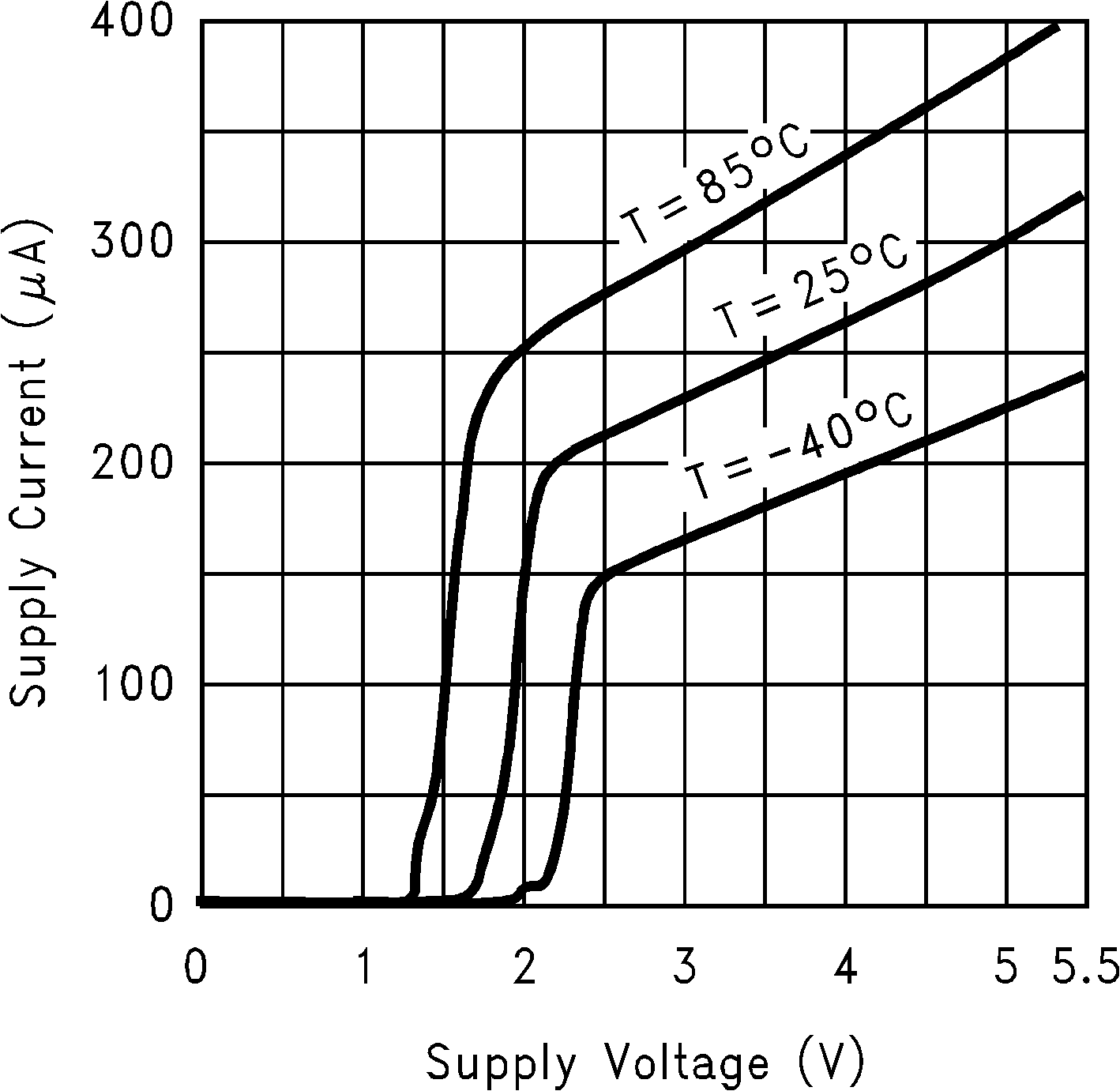
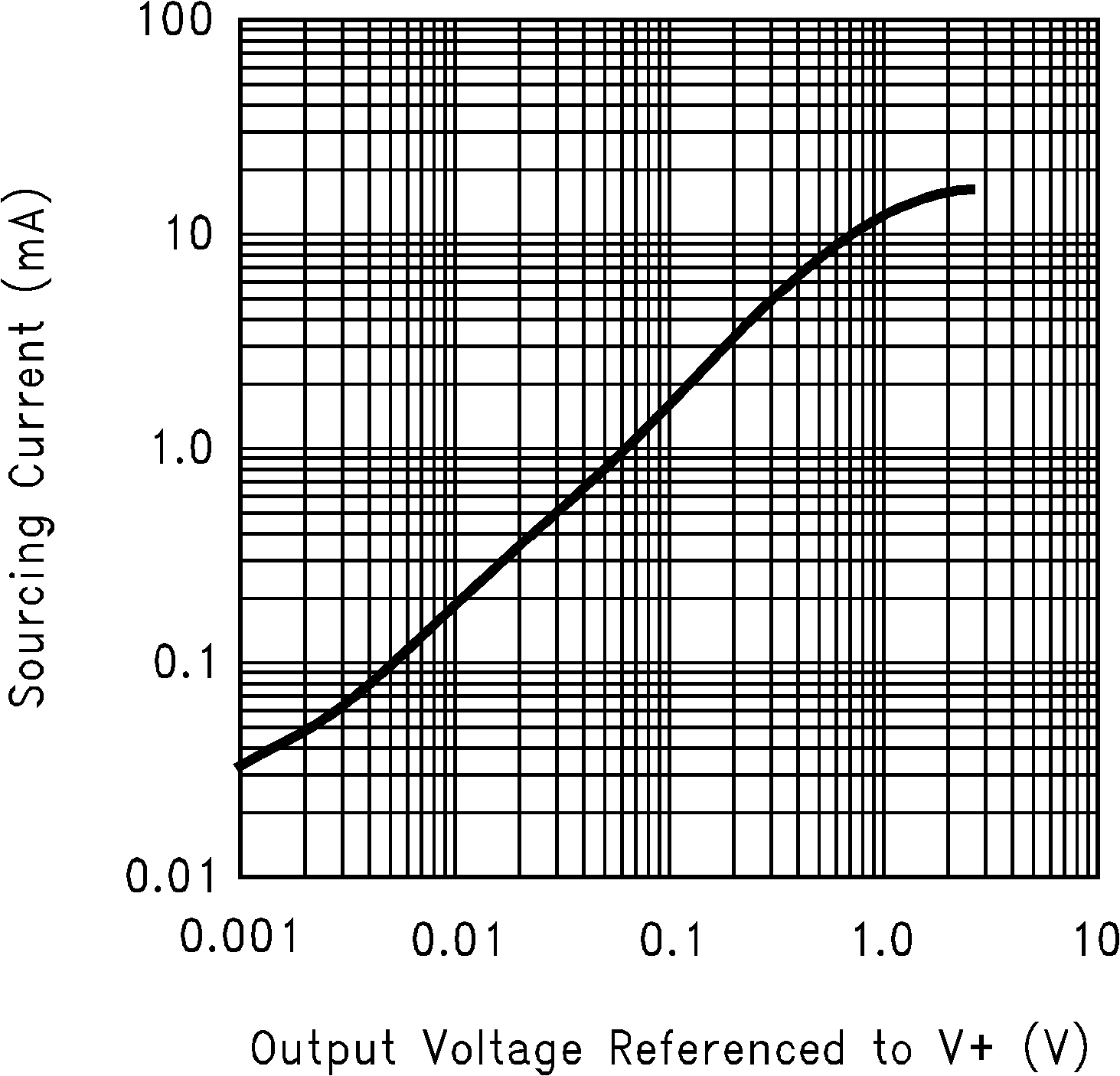
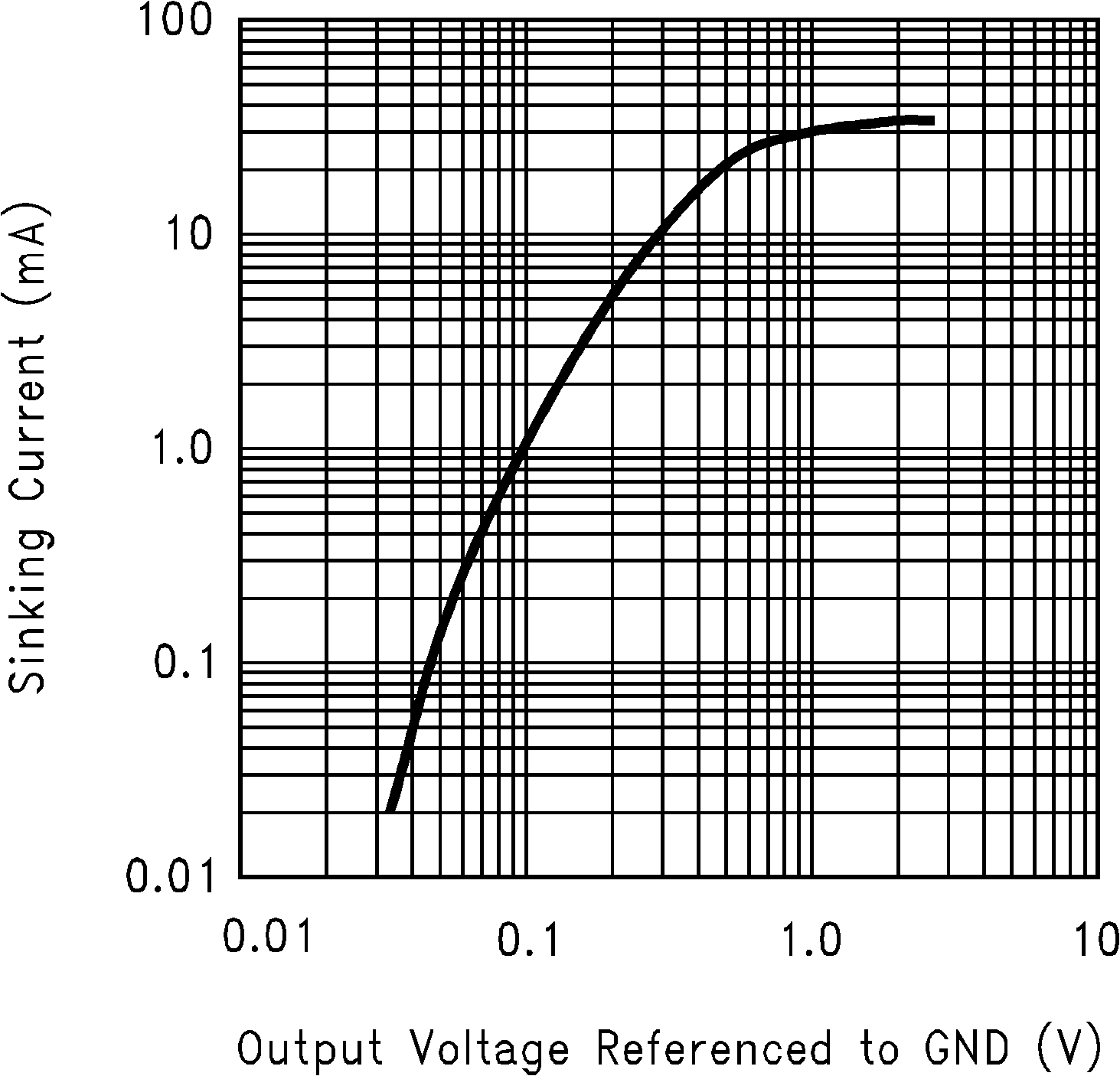
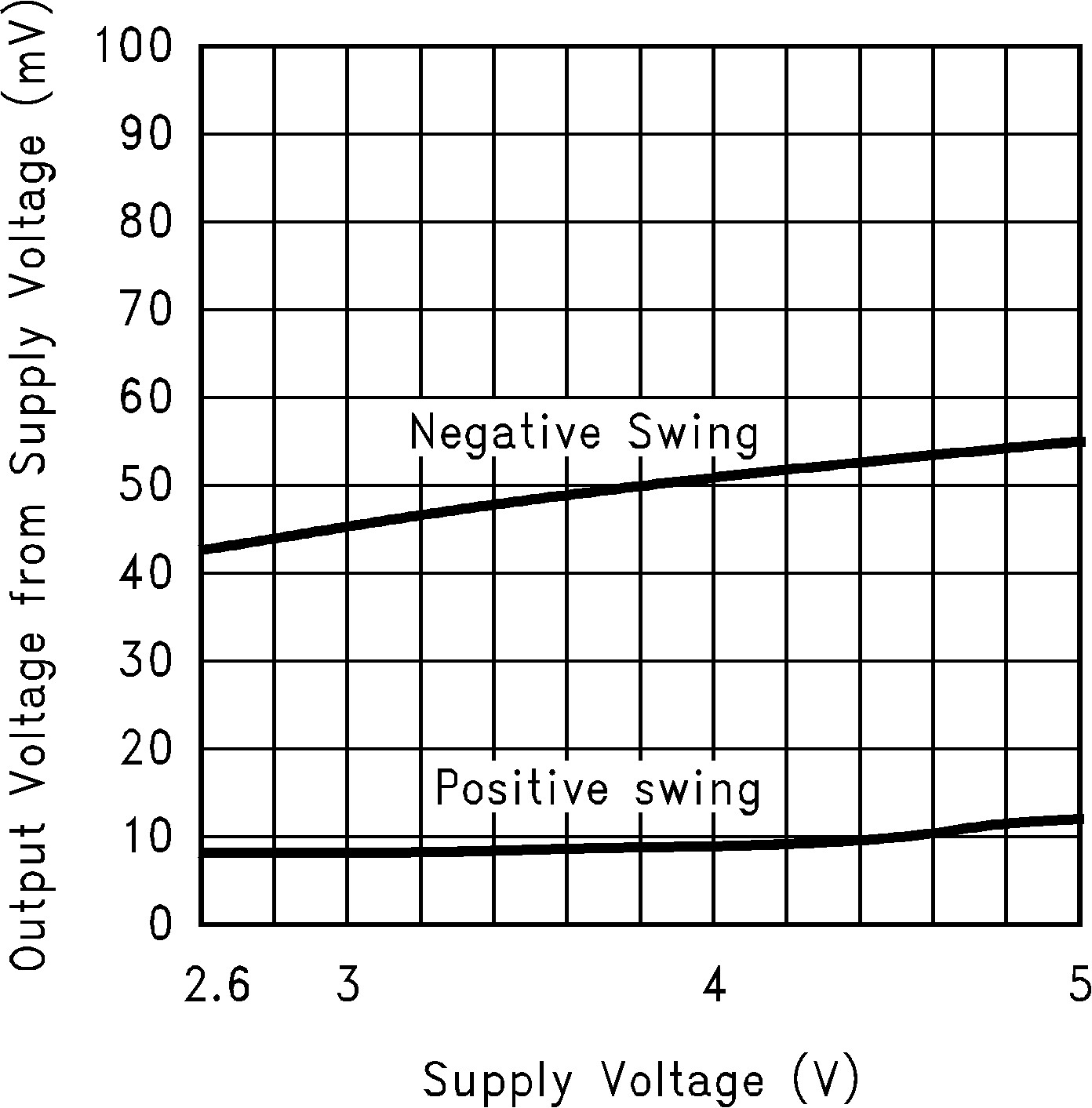
(RL = 10kΩ)
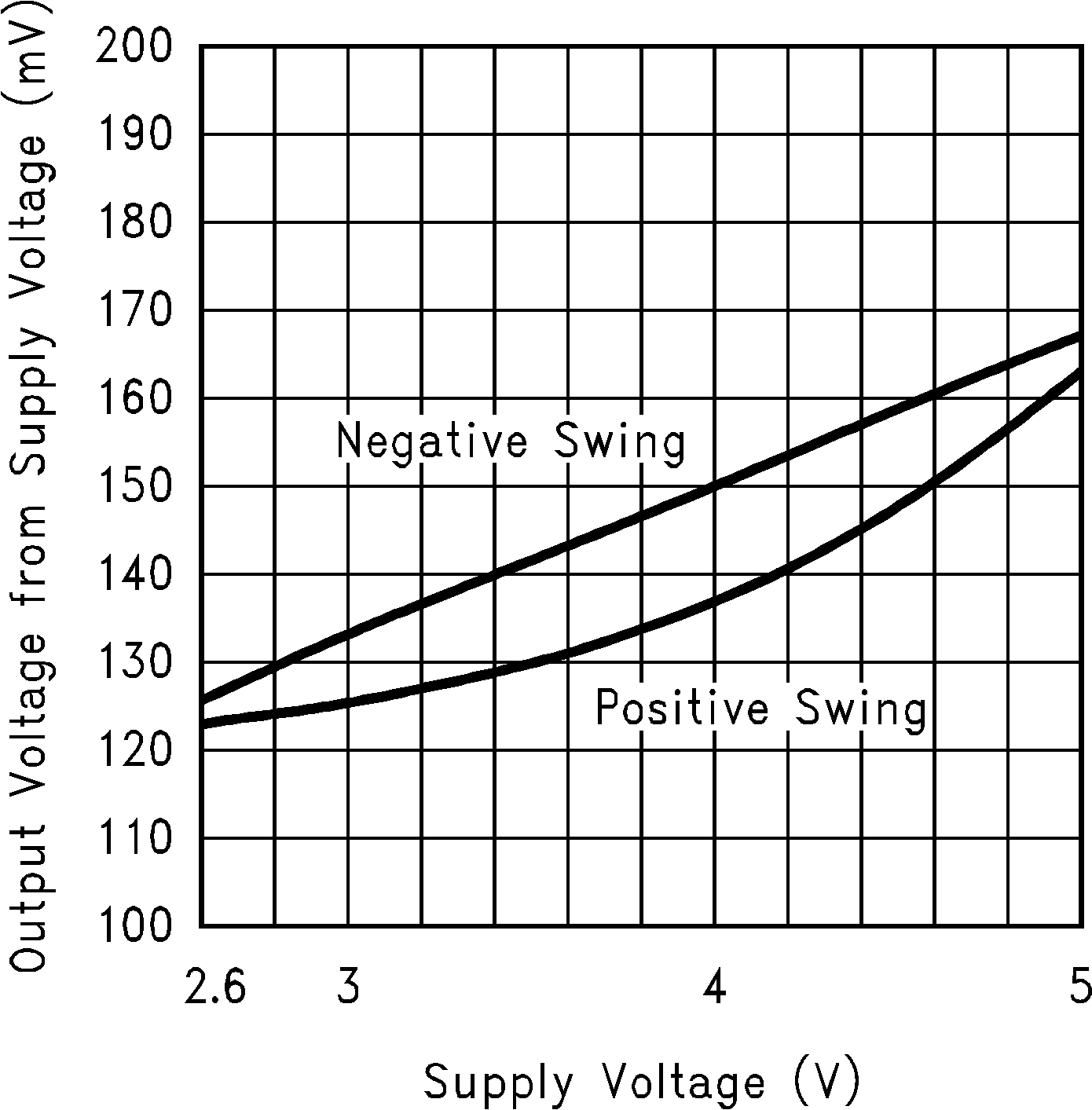
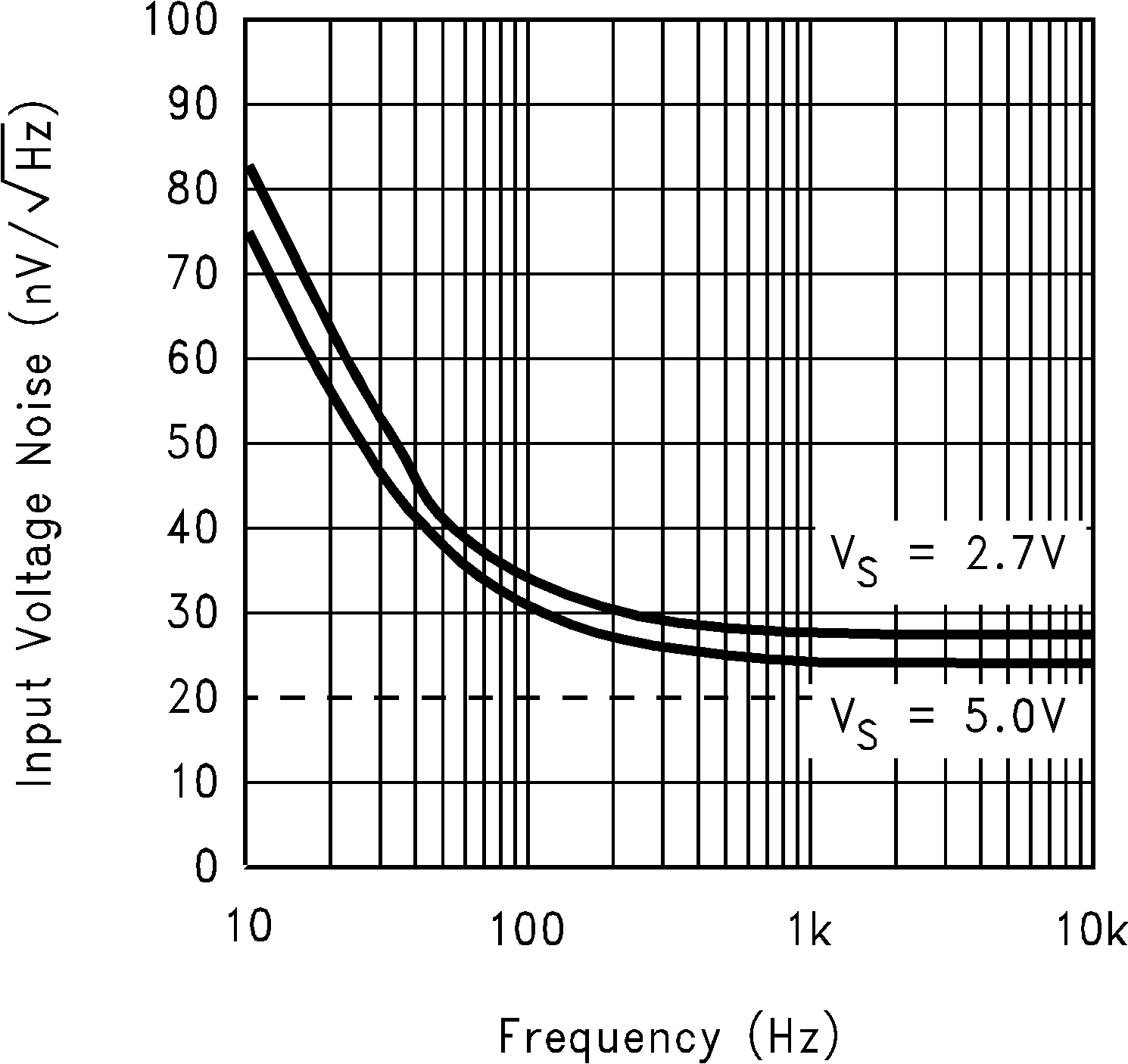
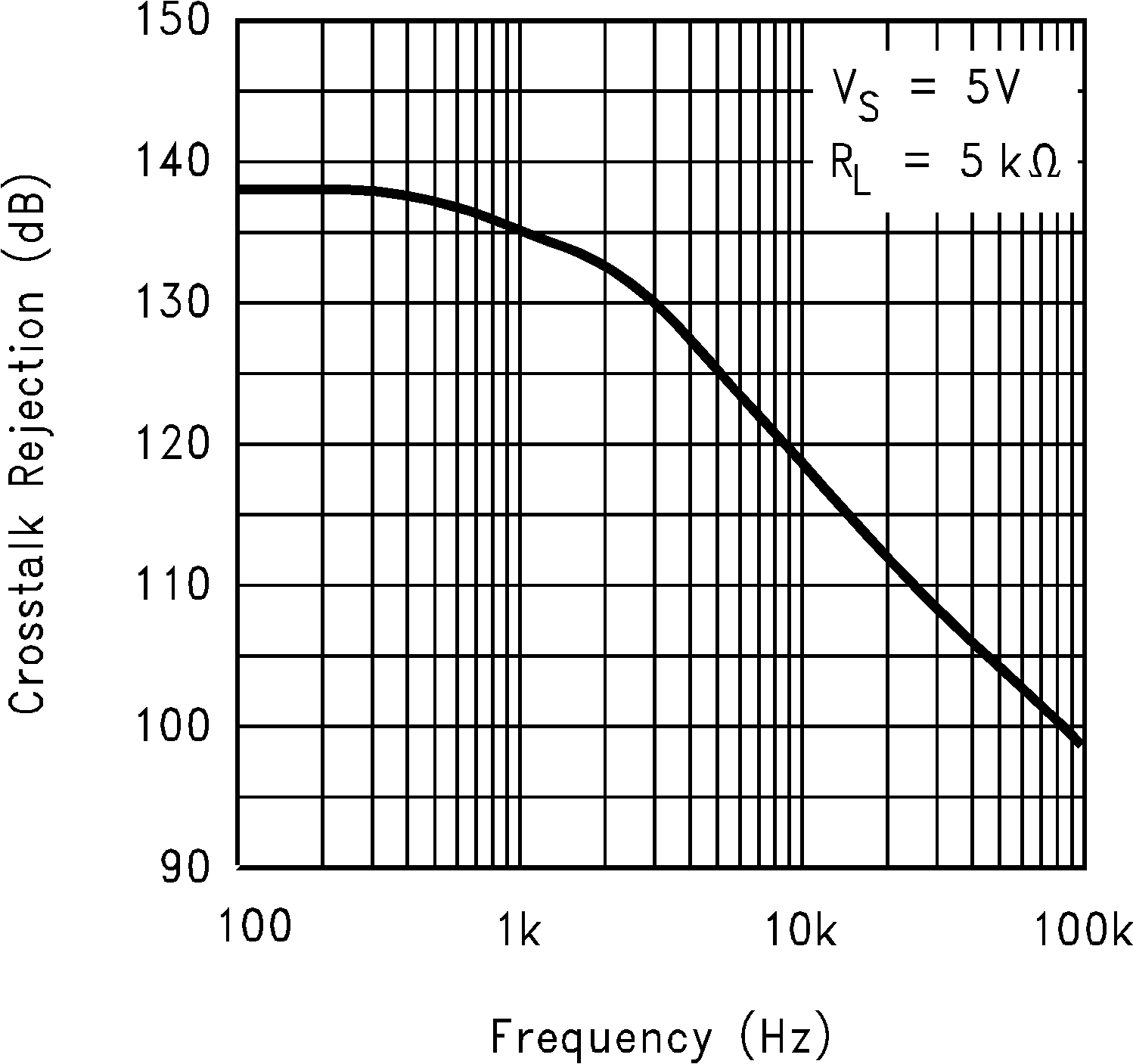
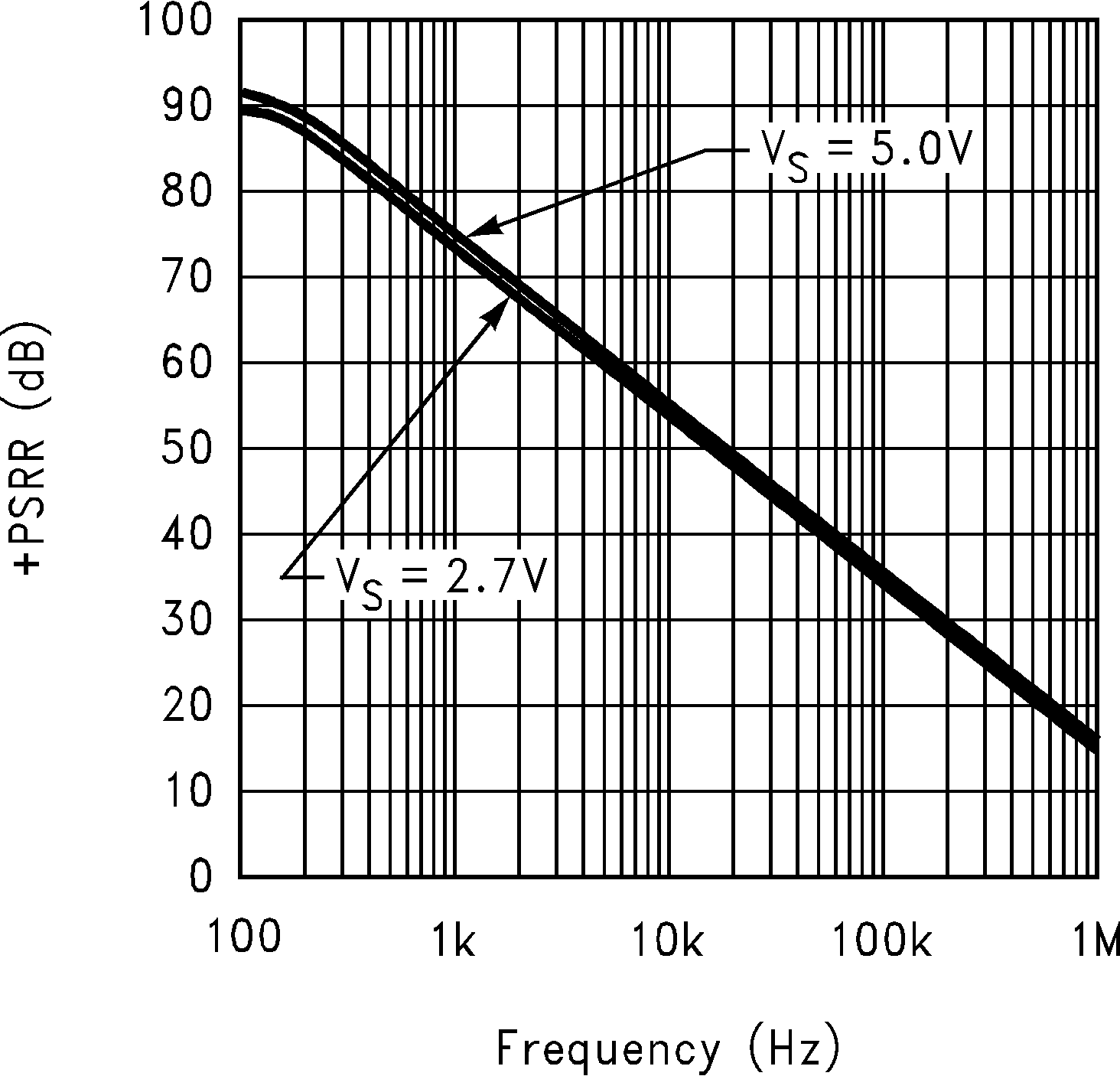
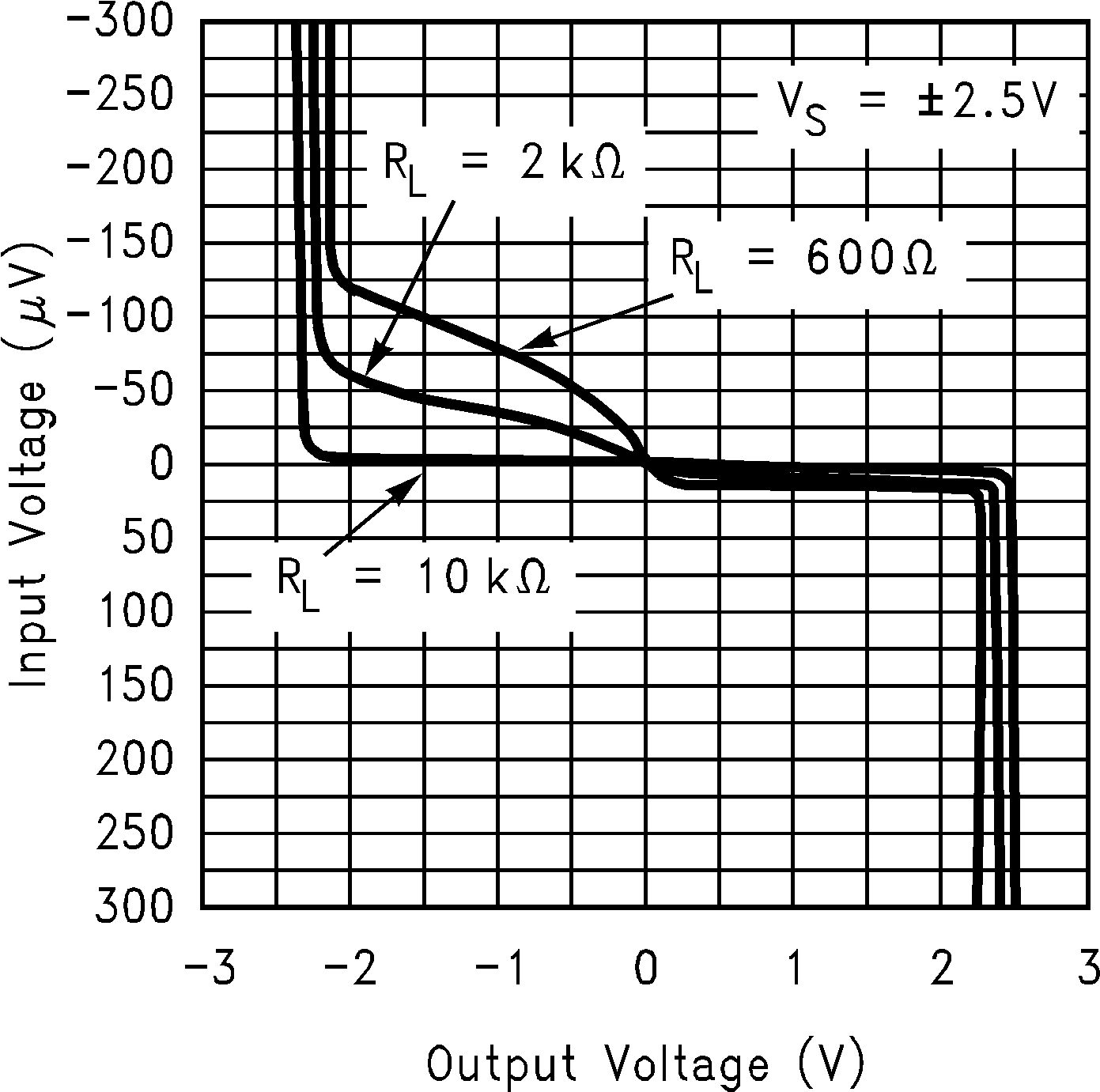
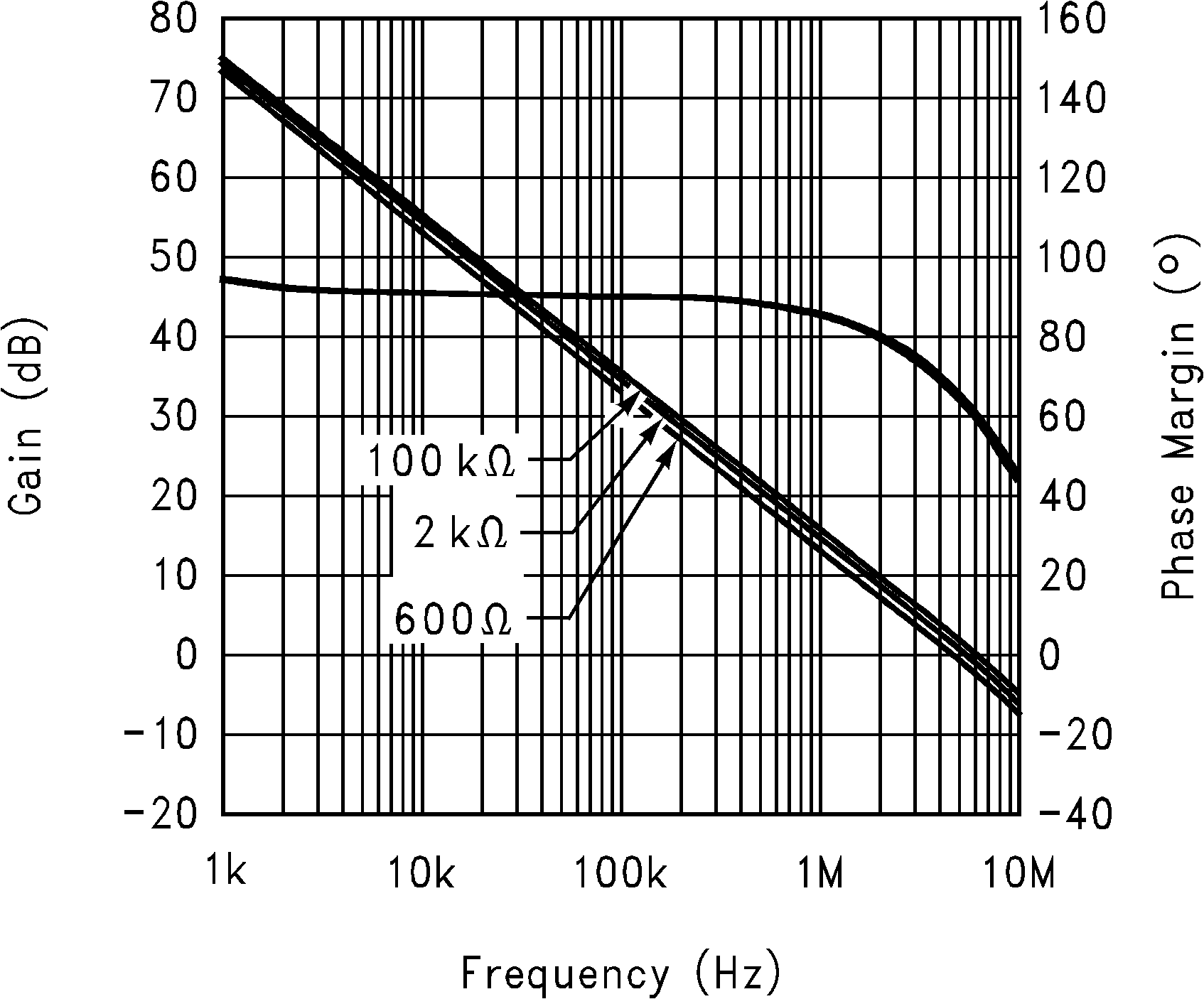
(RL = 100kΩ, 2kΩ, 600Ω) at 5V
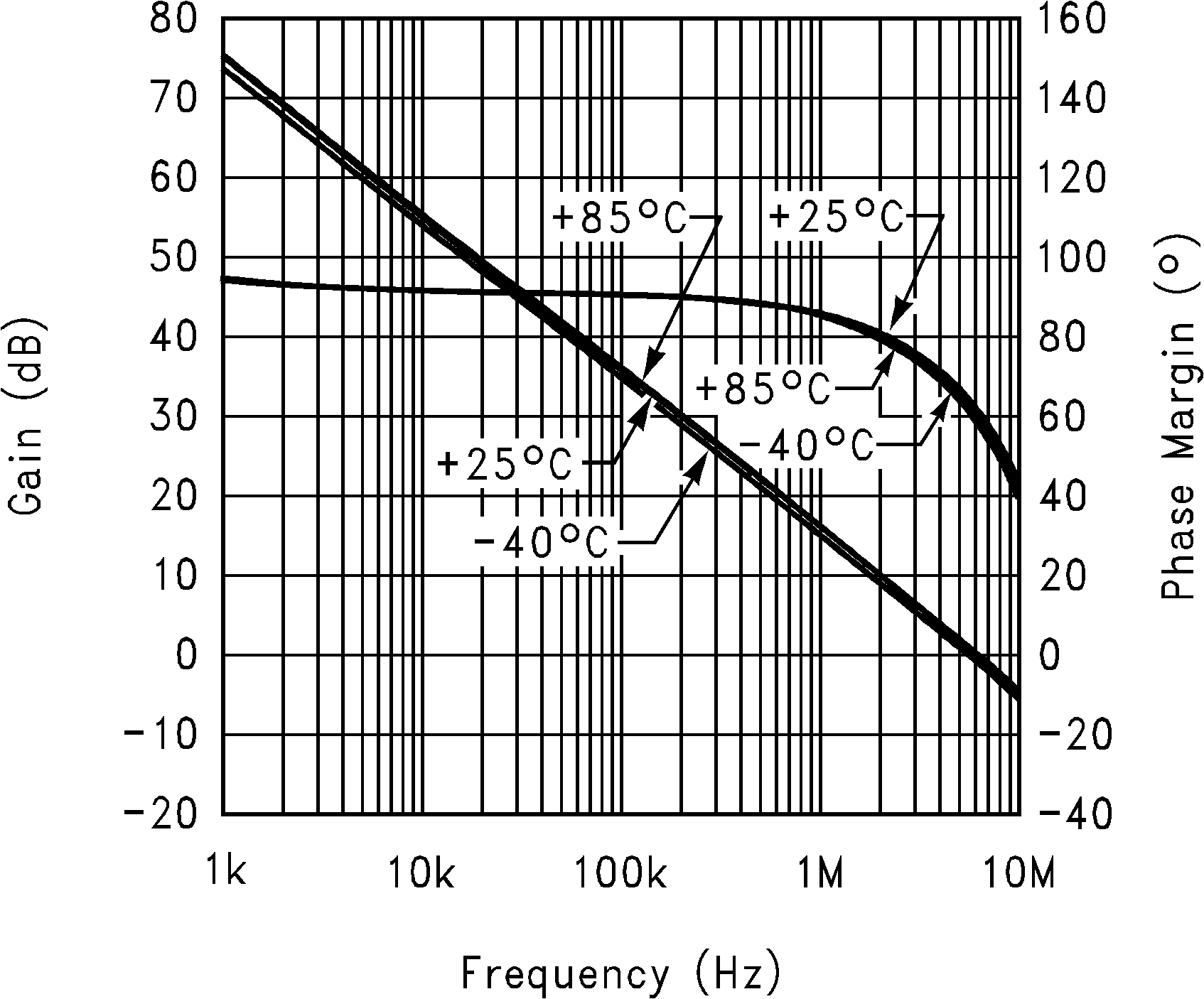
(Temp.= 25, -40, 85 °C, RL = 10kΩ) at 5V

(CL = 100pF, 200pF, 0pF RL = 10kΩ) at 5V
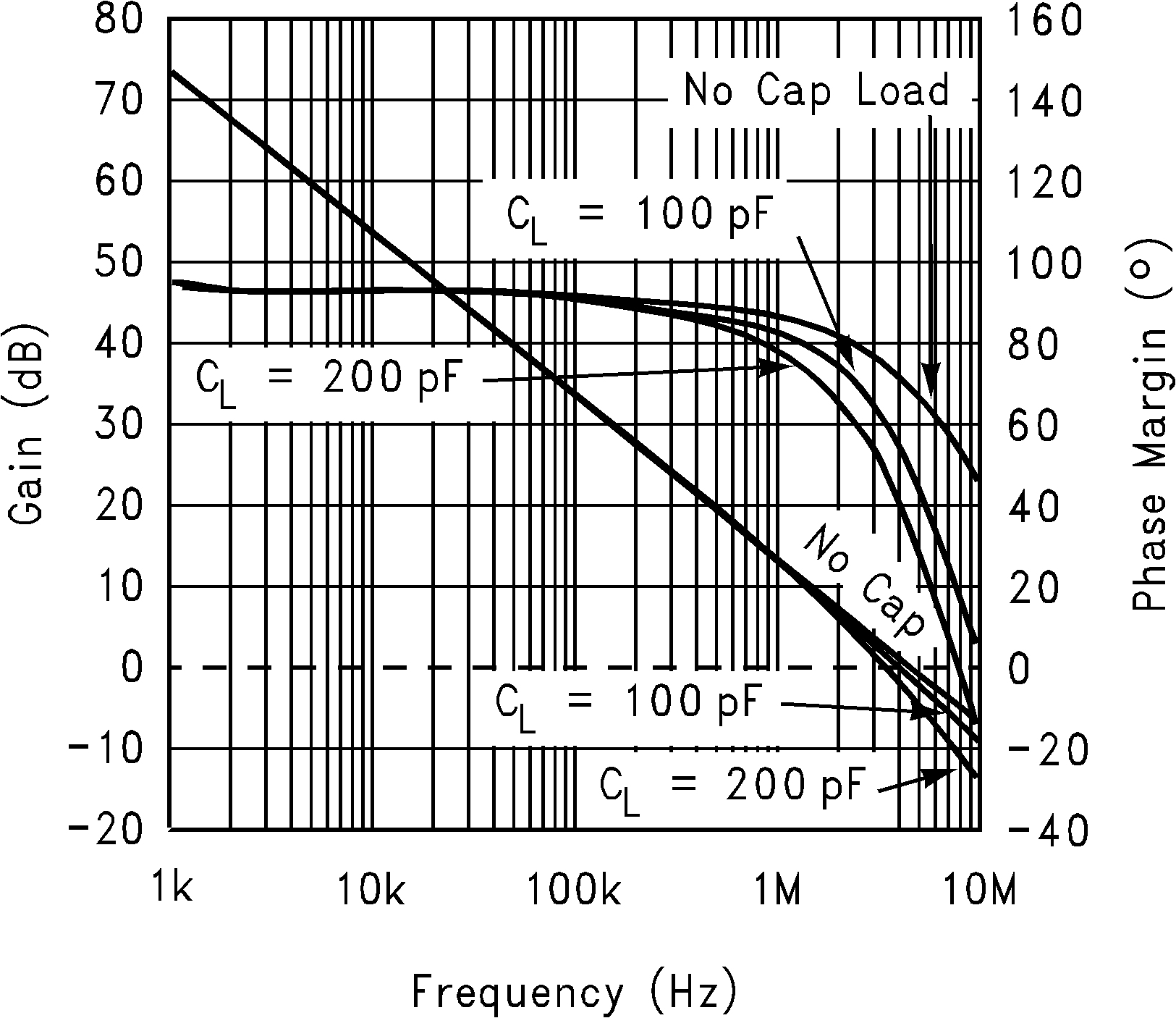
(CL = 100pF, 200pF, 0pF RL = 600Ω) at 5V
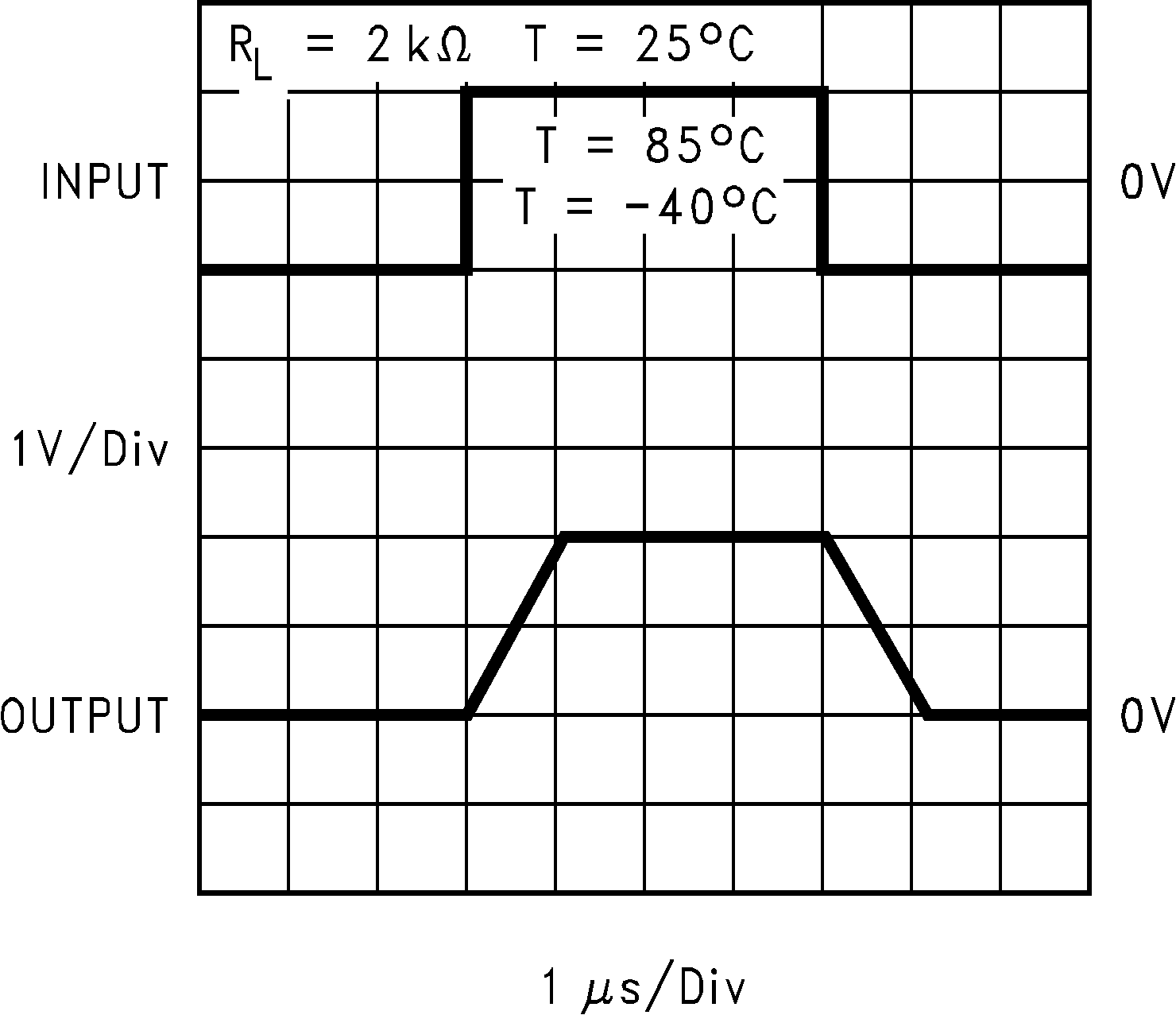
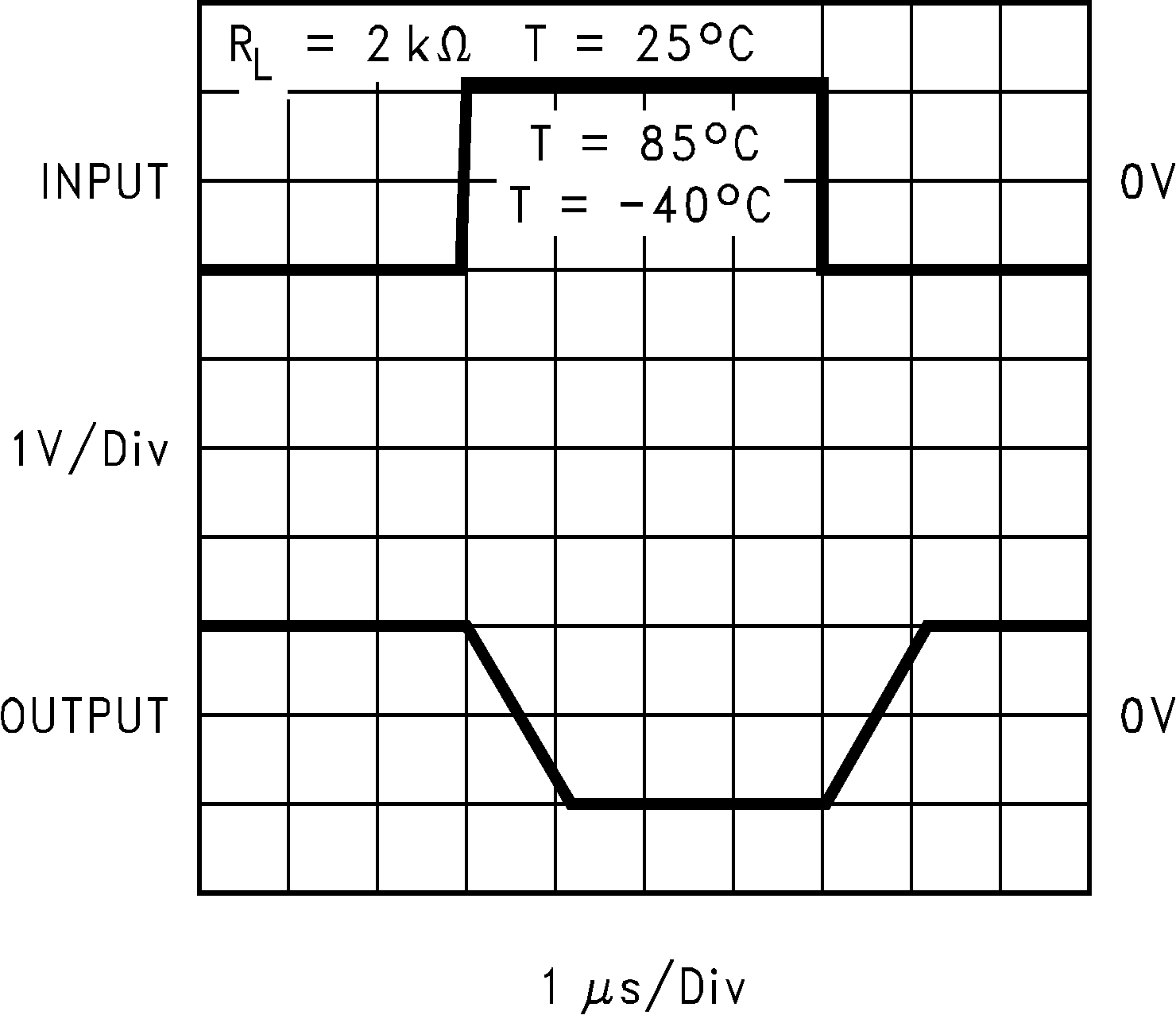
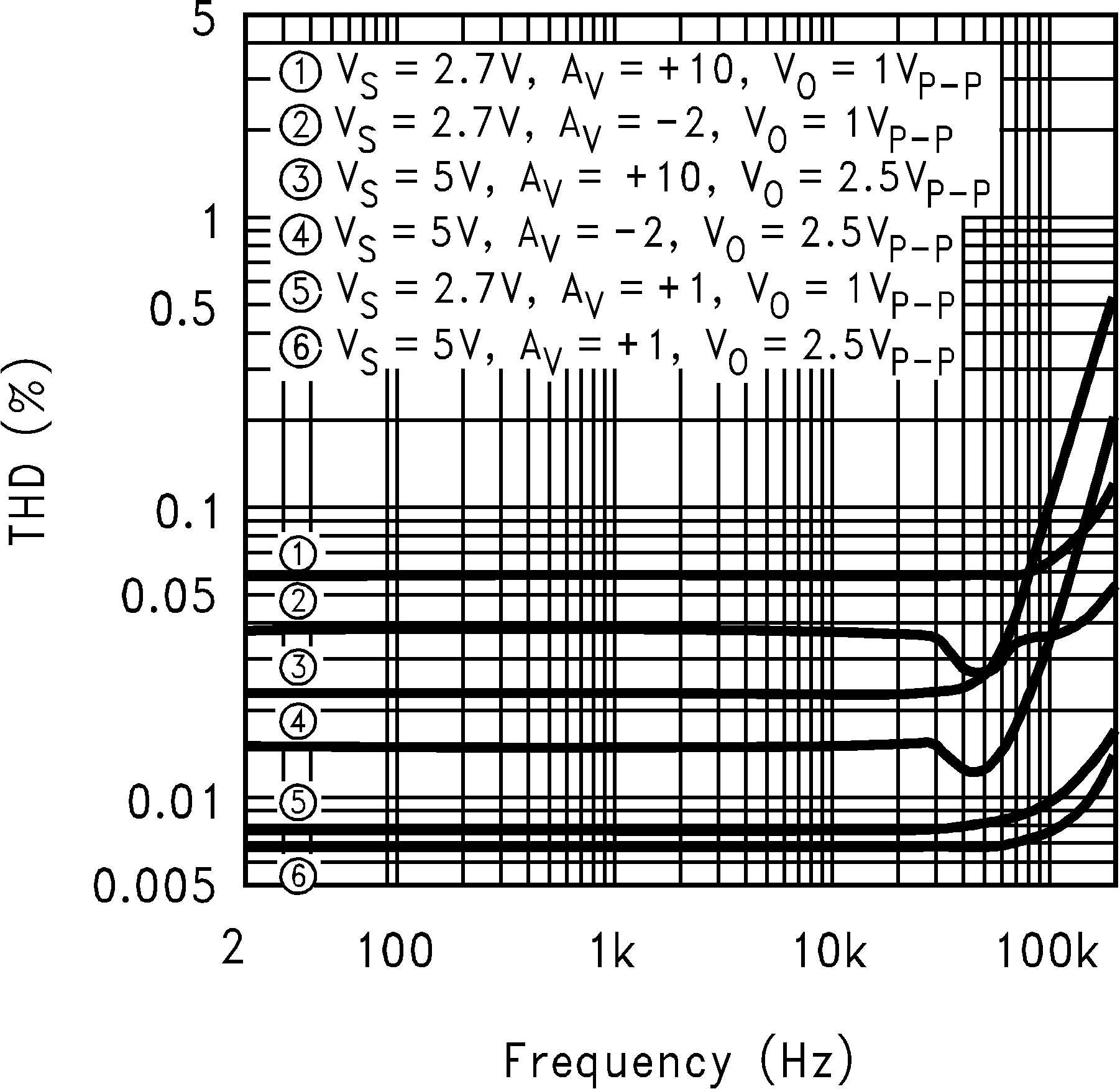
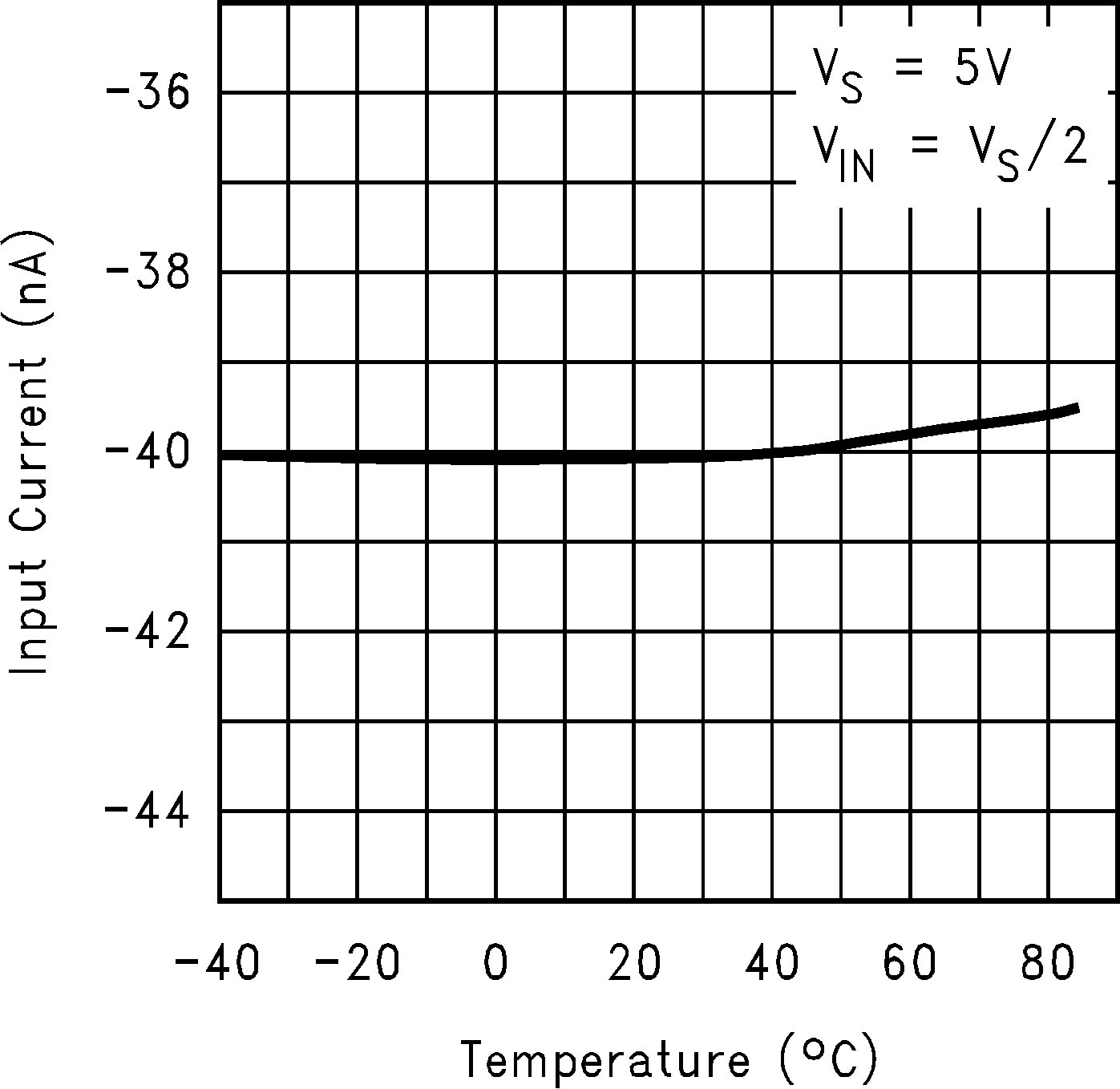
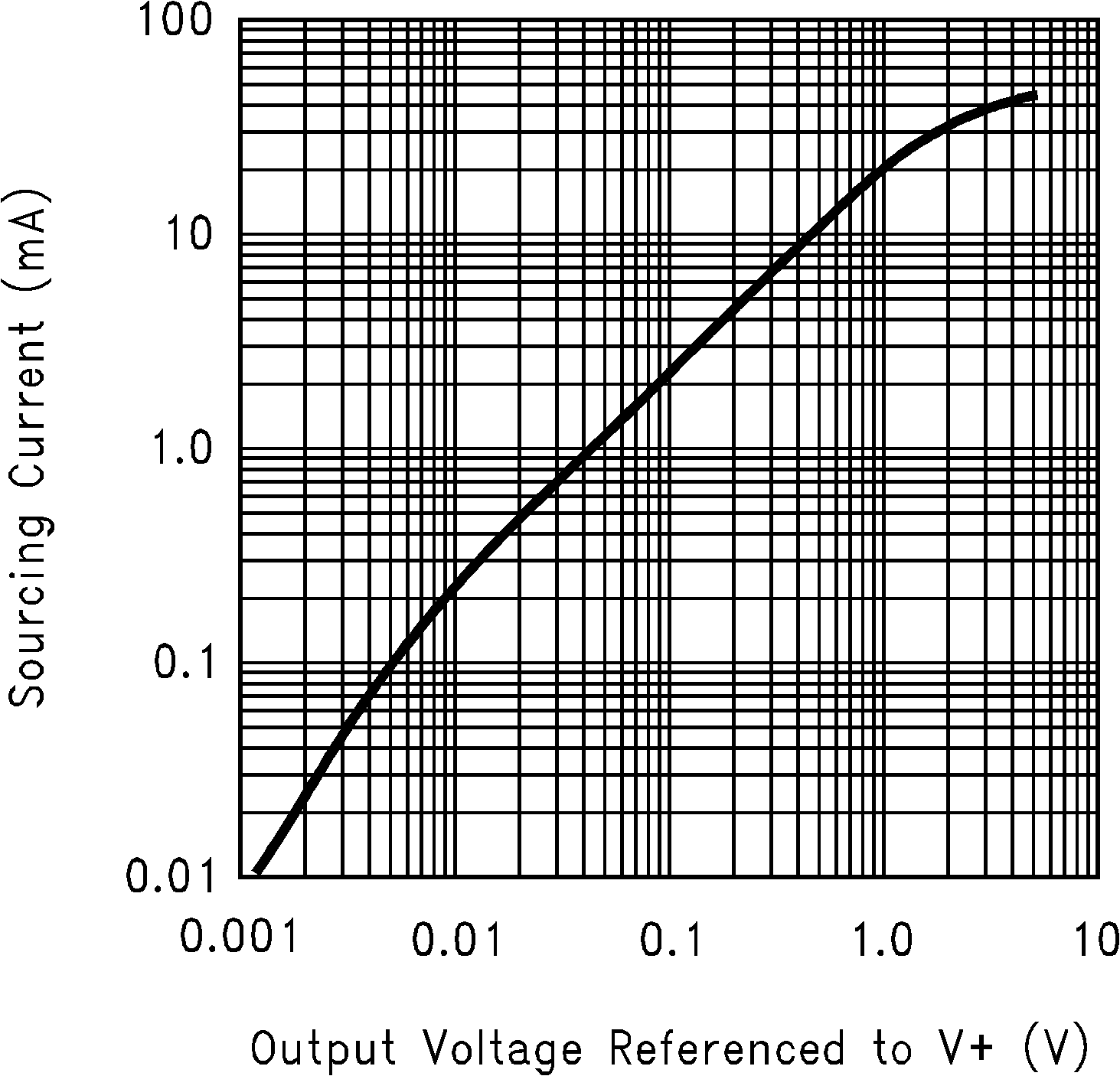
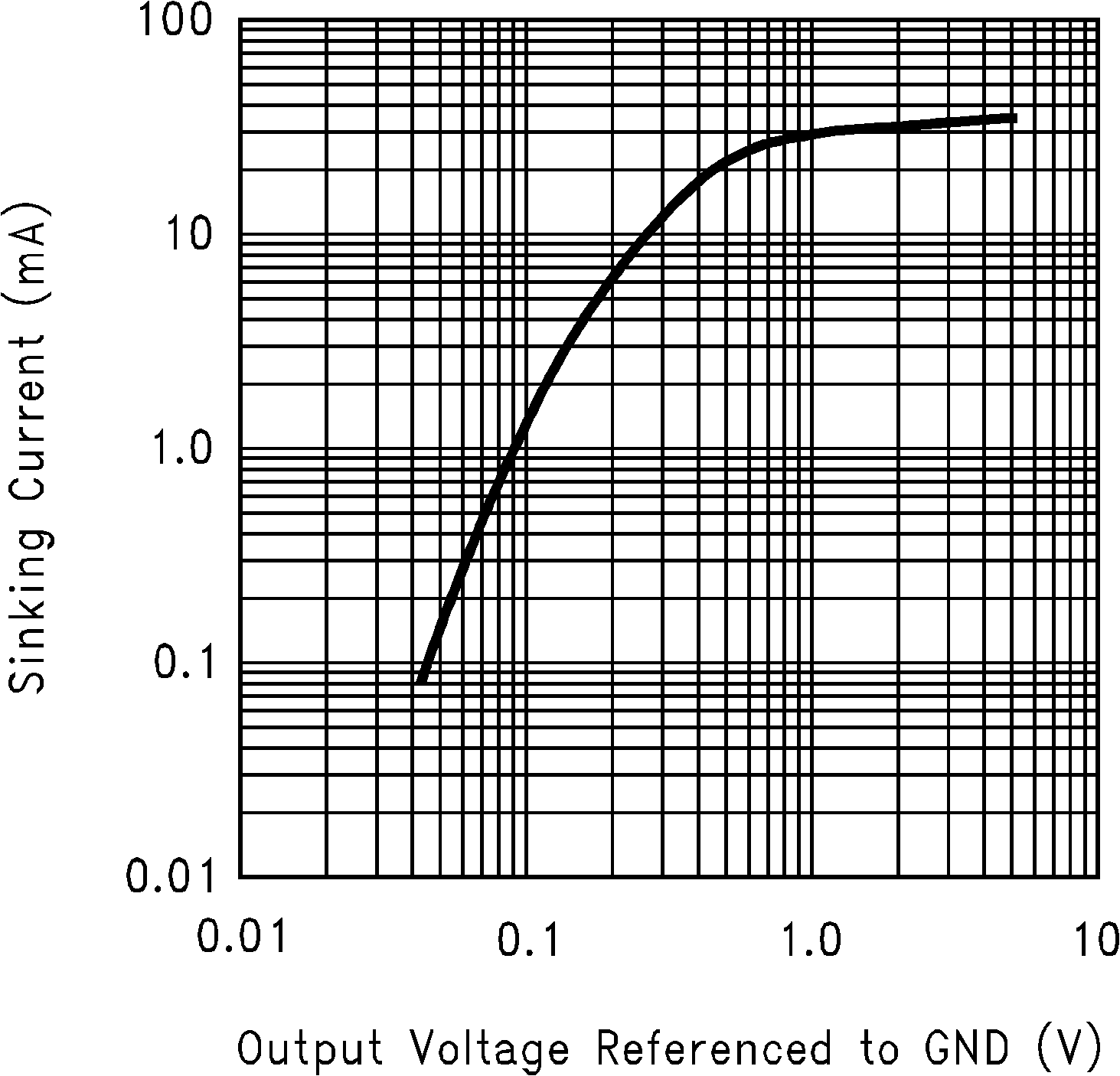
(VS = 5V)
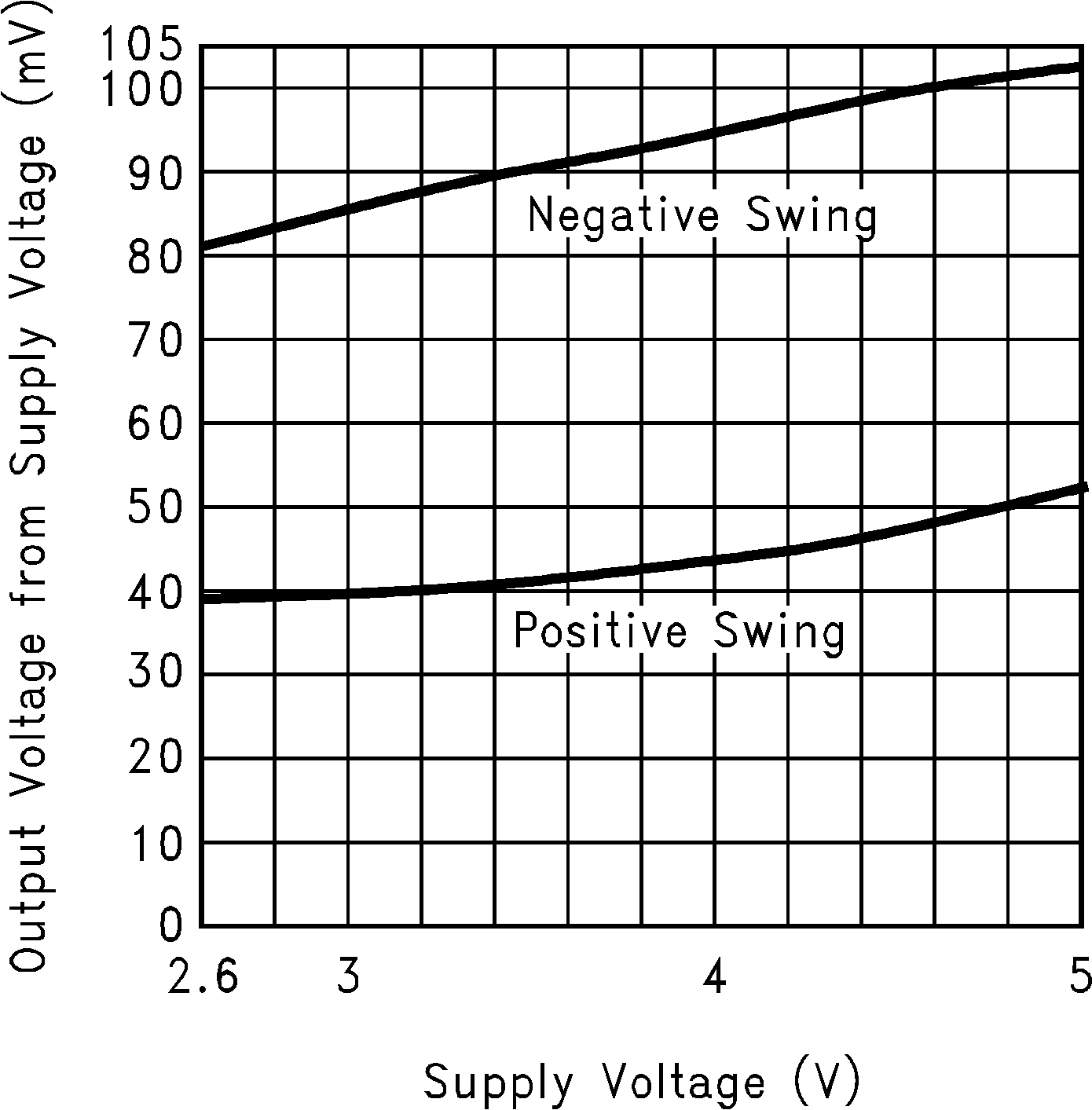
(RL = 2kΩ)
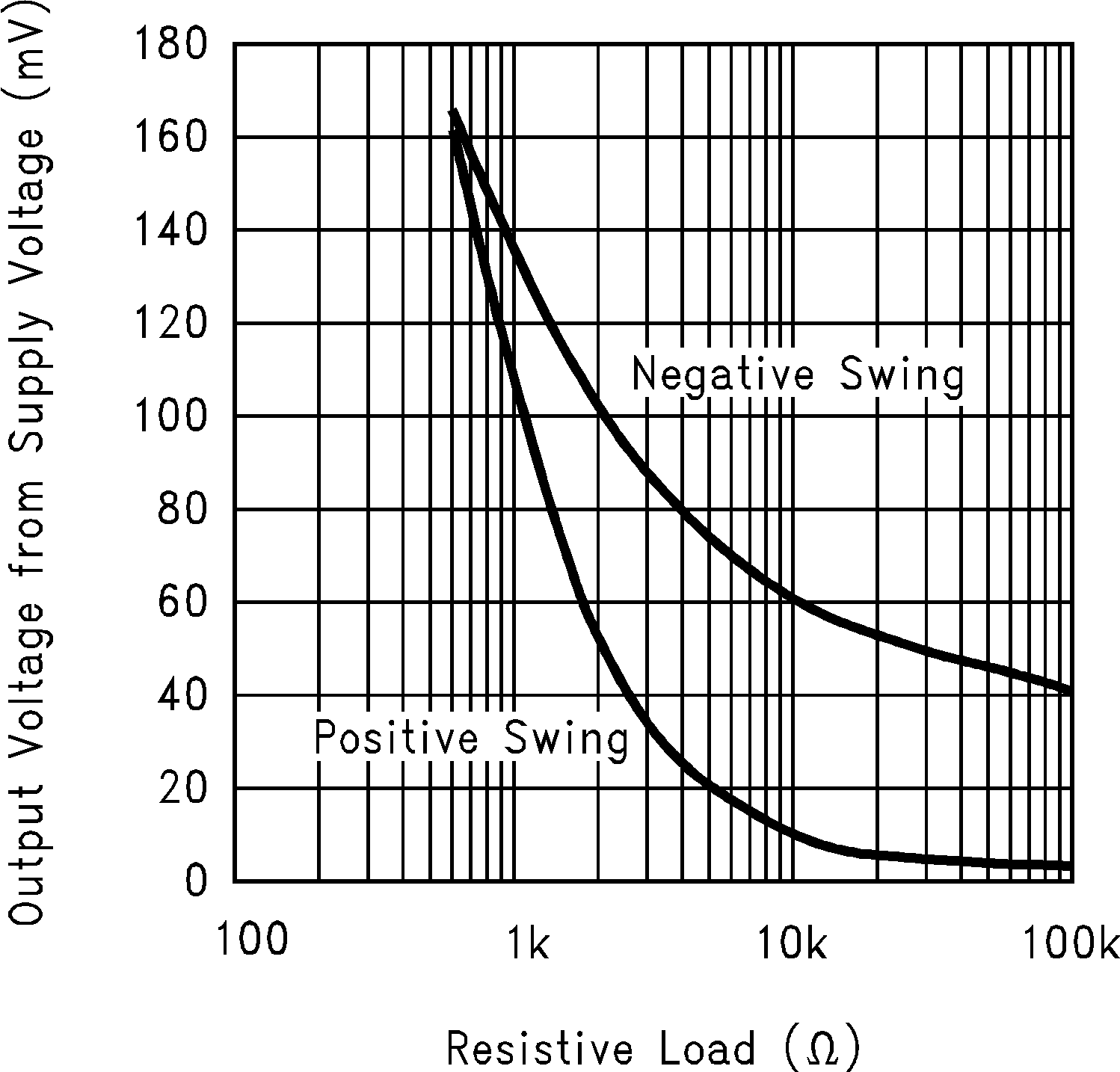
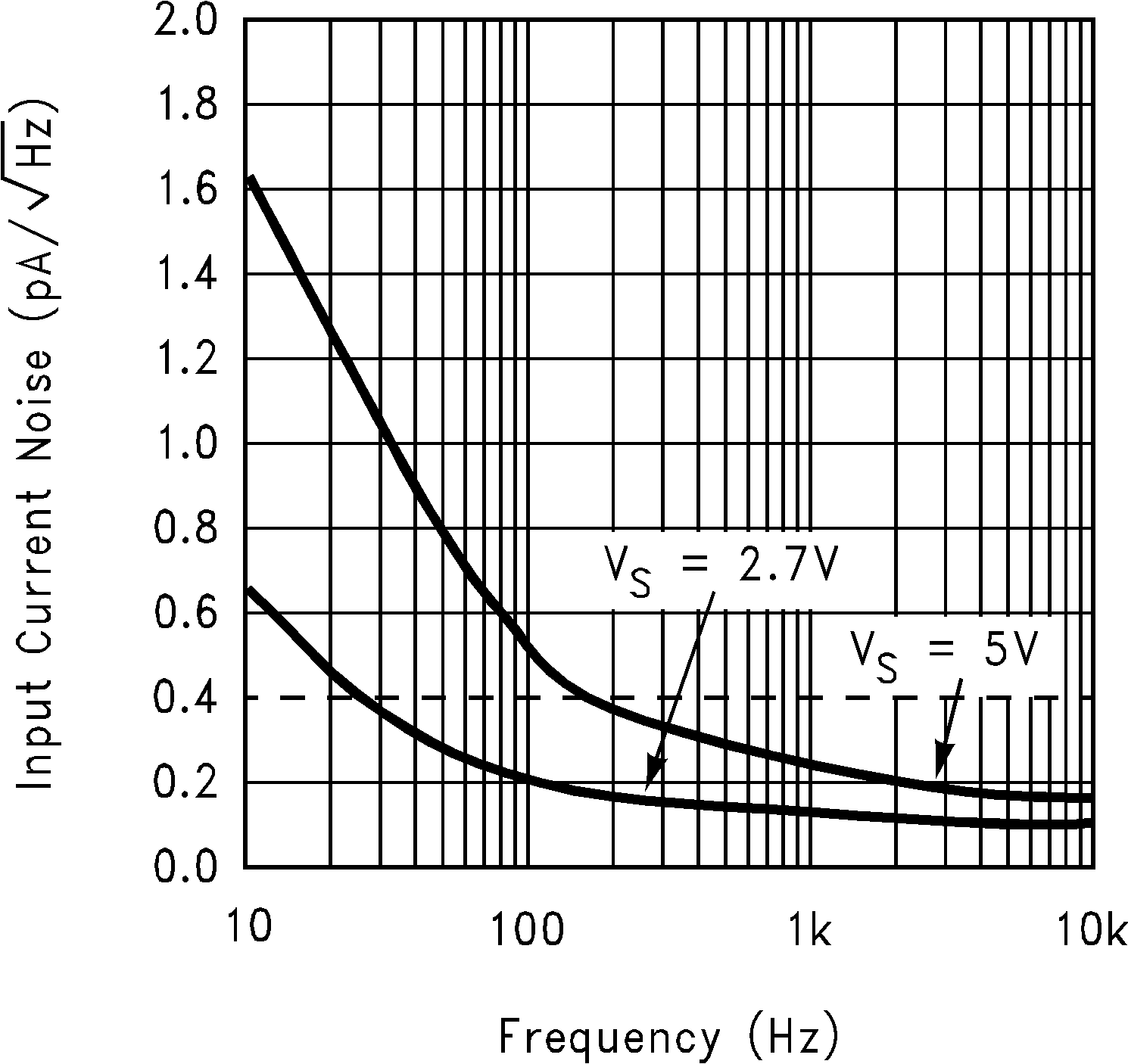
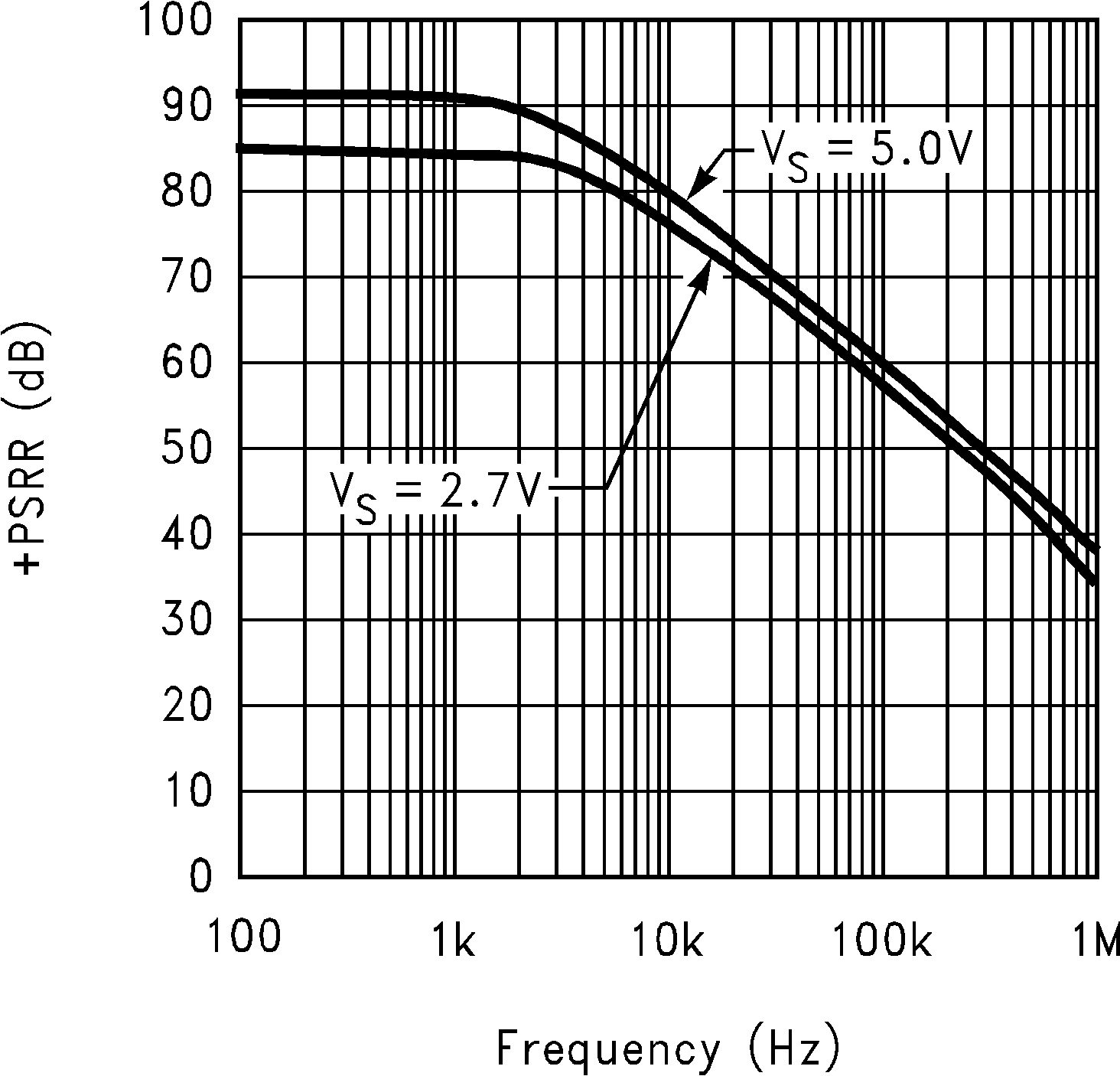
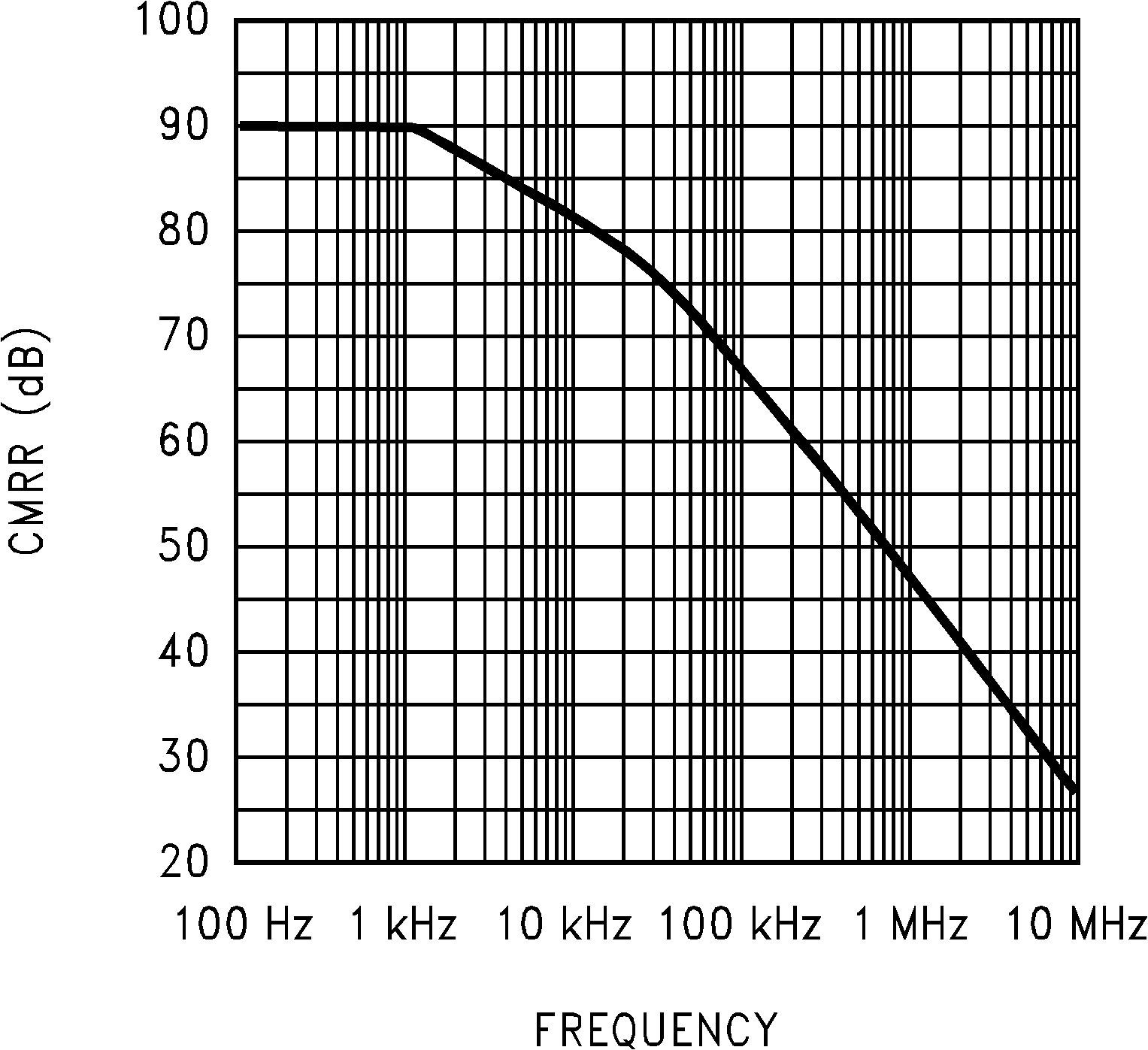
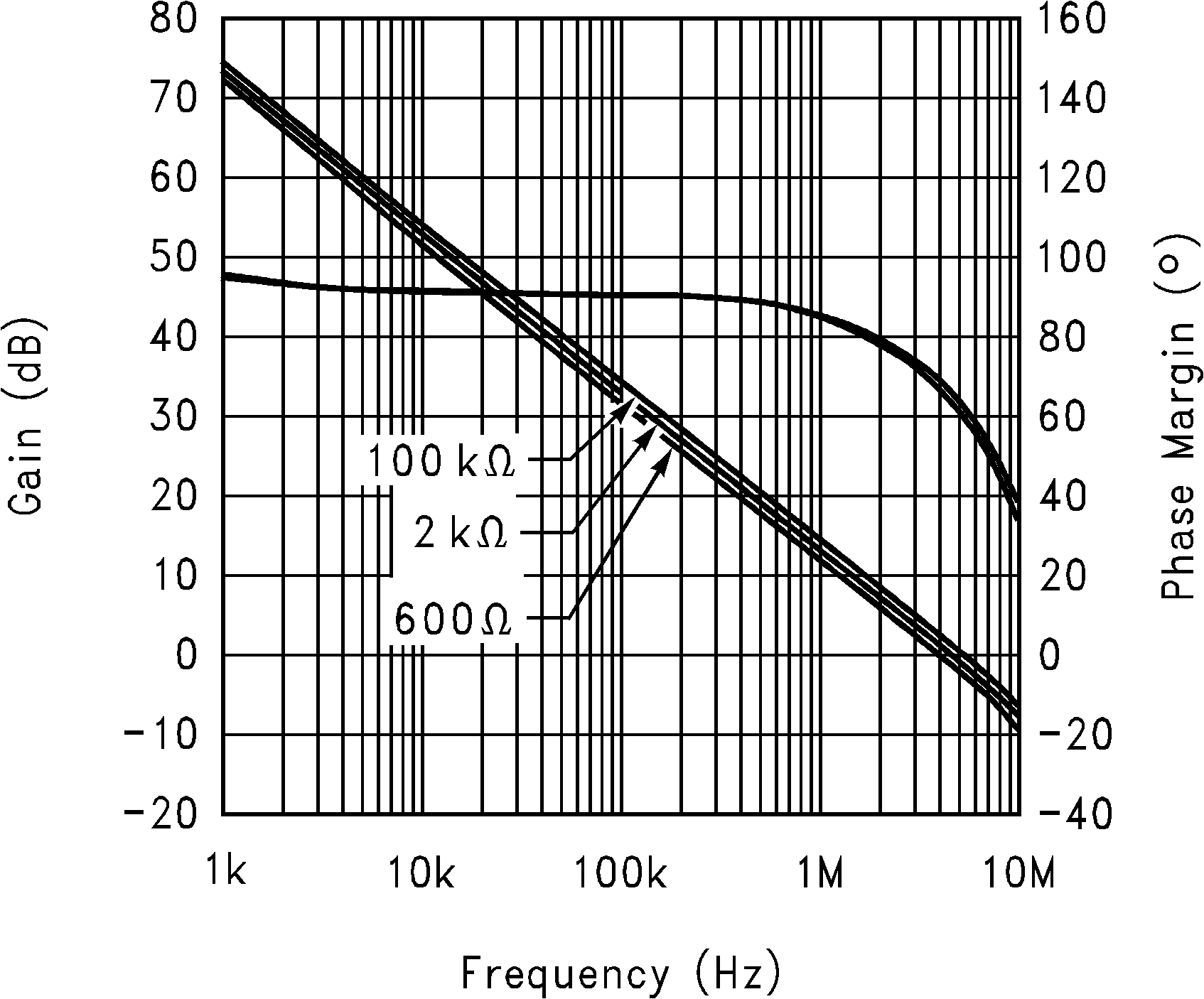
(RL = 100kΩ, 2kΩ, 600Ω) at 2.7V
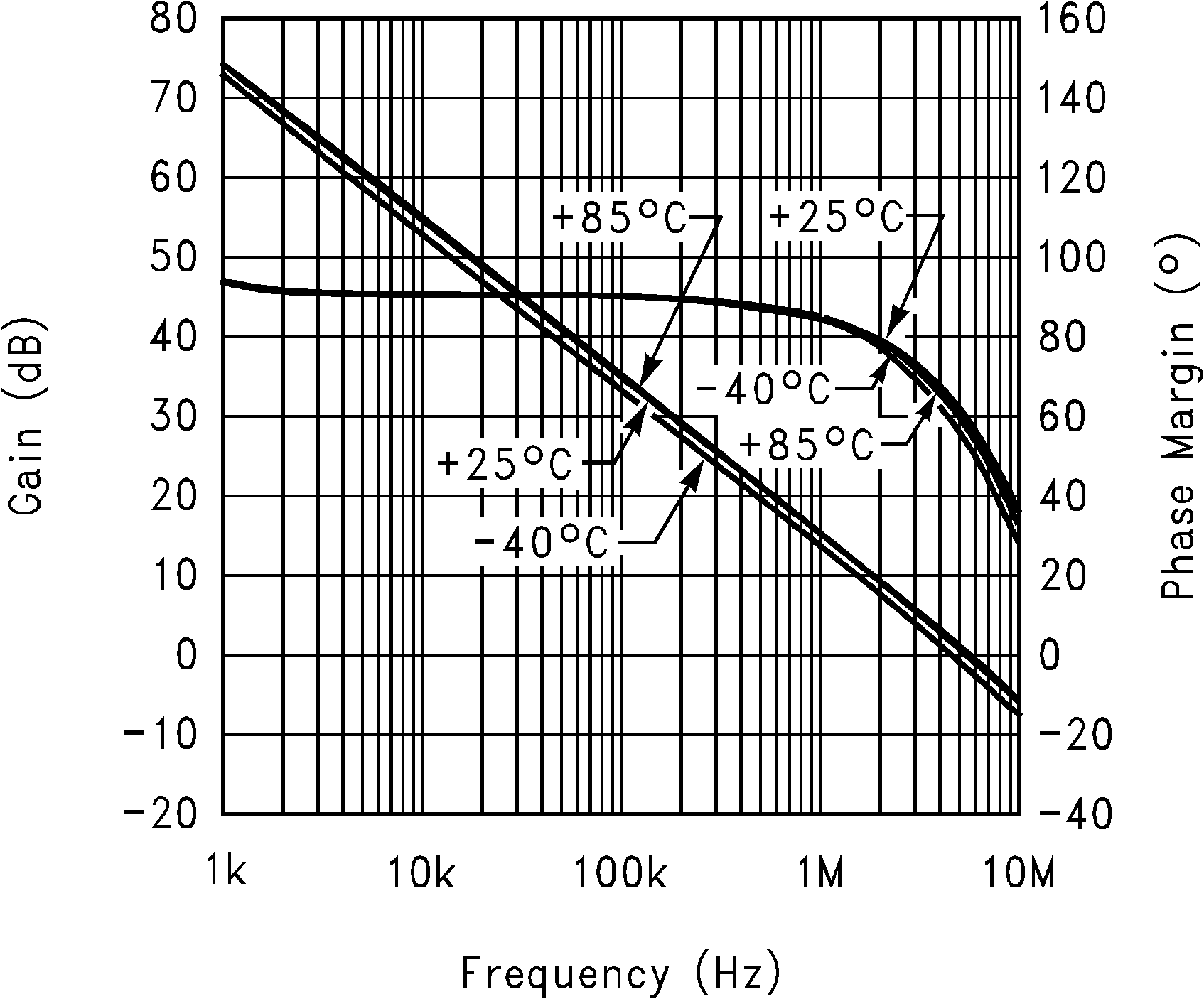
(Temp.= 25, -40, 85°C, RL = 10kΩ) at 2.7V
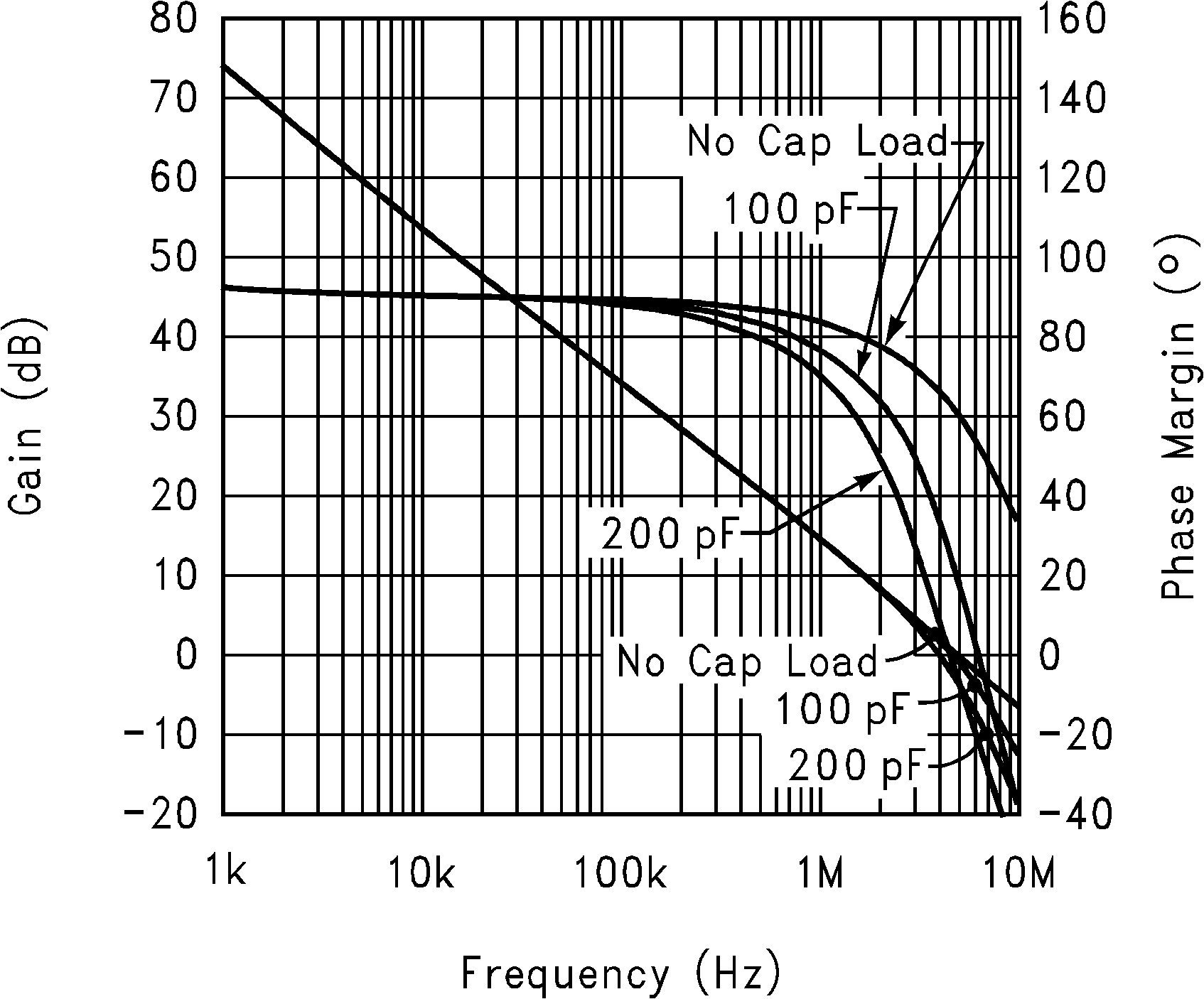
(CL = 100pF, 200pF, 0pF, RL = 10kΩ) at 2.7V
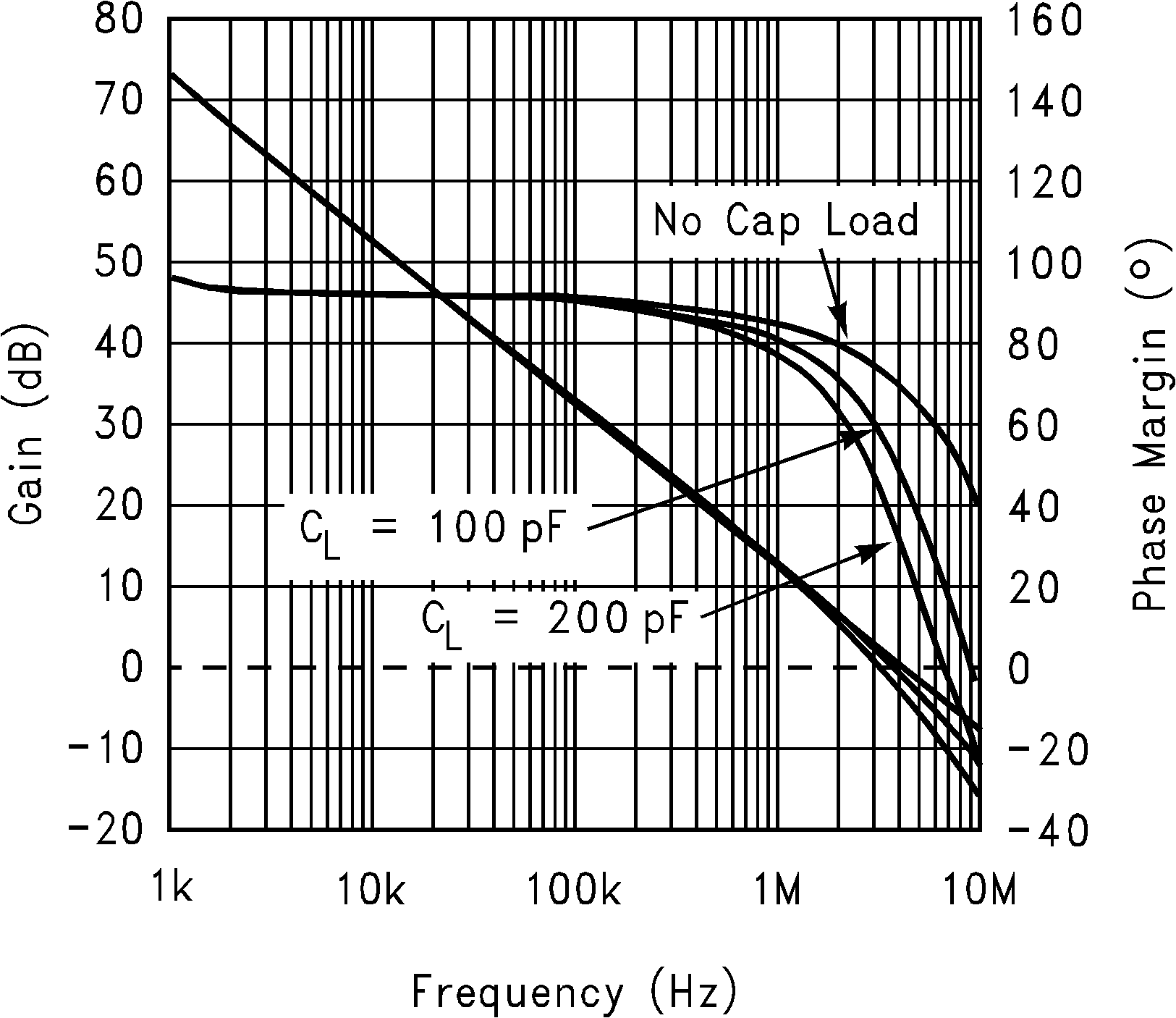
(CL = 100pF, 200pF, 0pF RL = 600Ω) at 2.7V
